MARIANI’S
Virtual
Gourmet
June 3,
2018
NEWSLETTER
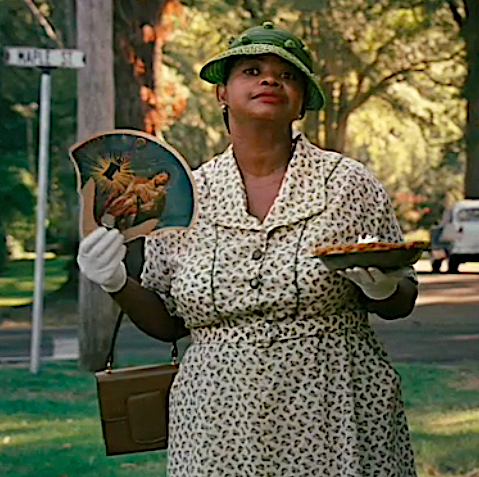
❖❖❖
IN THIS ISSUE
MIAMI
Part One
By John Mariani
Ella
Brennan, Empress of New Orleans’
Restaurant Scene, Dies at 92.
By John Mariani
NEW YORK CORNER
MOLYVOS
By John Mariani
NOTES FROM THE WINE CELLAR
MIONETTO INSISTS PROSECCO
IS NOT CHAMPAGNE
By John Mariani
❖❖❖
MIAMI
Part One
By John Mariani
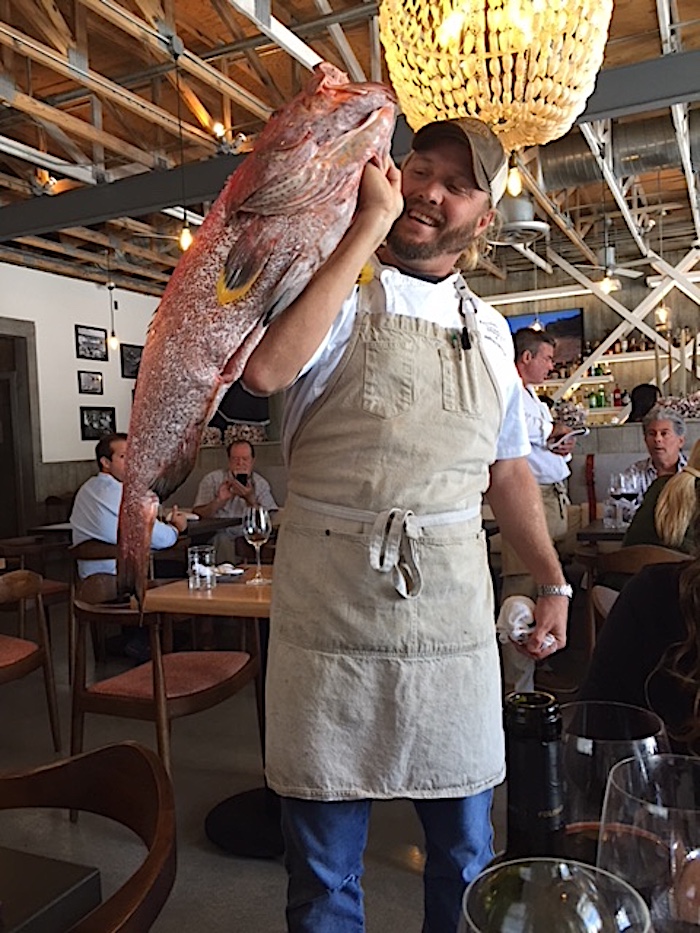
Jeff McInnis of Stiltsville Fish Bar
A perception
exists among snobs who have not dined out
around Miami that the restaurants have glitz
but no gravity. This was never really the
case, though in the sobering years following
the flamboyance of the Gianni Versace
period, when steamy glamour outshone good
taste, new Miami restaurants of real
excellence have been few; the wonderful old
Jewish delis have disappeared, the
innovations of the so-called New Floridian
Cuisine have pretty much receded; and the
promised explosion of restaurants in the
Design District never really happened. Still,
on a recent trip to the city I found some
very good places that may not be breaking
new ground but are helping to solidify
Miami’s dining out reputation.
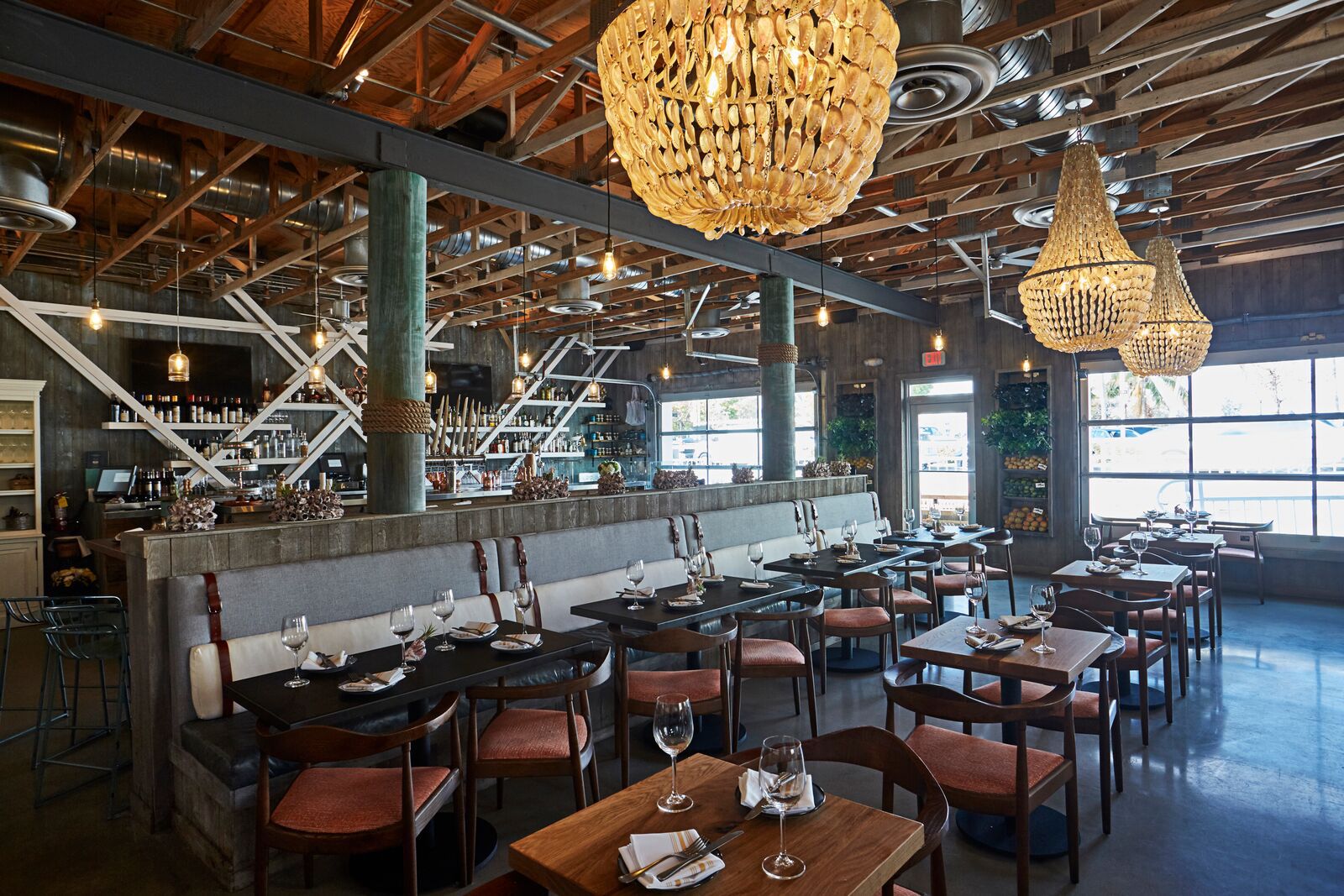 STILTSVILLE FISH BAR
STILTSVILLE FISH BAR
1787 Purdy Avenue
786-353-0477
Few restaurants in Miami
have a décor that so perfectly sums up the style
and spirit of this Sunset Harbour newcomer,
which cannily adapts the look of a much rougher
version of an old Florida fish house to colorful
advantage.
Opened last fall and named
after a group of wooden houses set on stilts on
the banks of Biscayne Bay back in the 1920s,
Stiltsville Fish Bar has a smart-looking bar,
outdoor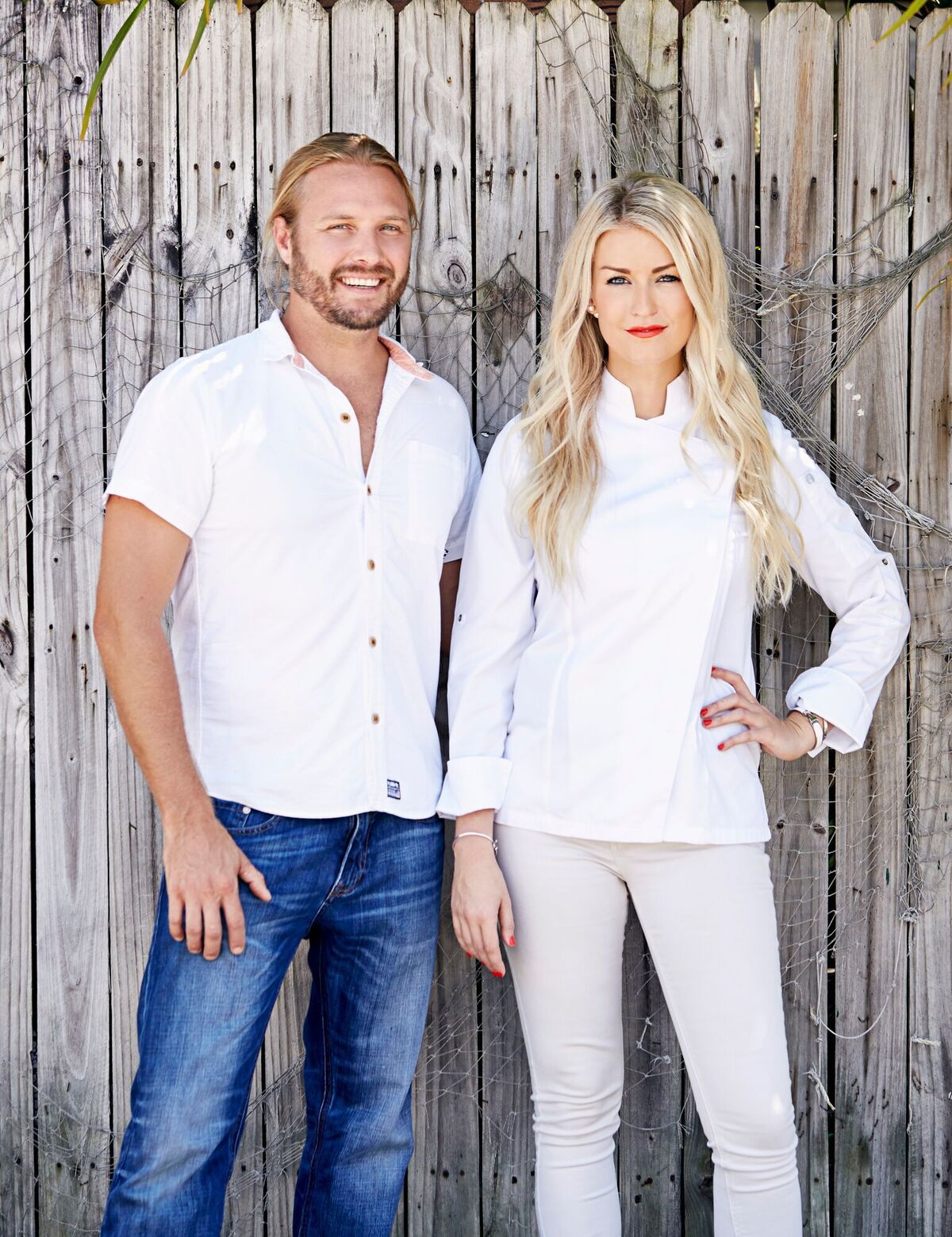 and
indoor seating, barnacle planters, brass purse hooks
in the shape of
Poseidon with his trident, beer
tap handles made from swordfish bills, shell
chandeliers and wooden columns that evoke the
original houses, which are shown in
black-and-white photos of the era.
and
indoor seating, barnacle planters, brass purse hooks
in the shape of
Poseidon with his trident, beer
tap handles made from swordfish bills, shell
chandeliers and wooden columns that evoke the
original houses, which are shown in
black-and-white photos of the era.
Owners Jeff McInnis and
Janine Booth (right),
who also run Root and Bone in New York, could have
coasted with a menu typical of many Florida fish
houses, but Stiltsville outpaces that genre by,
first, obtaining only the finest seafood available
on a daily, local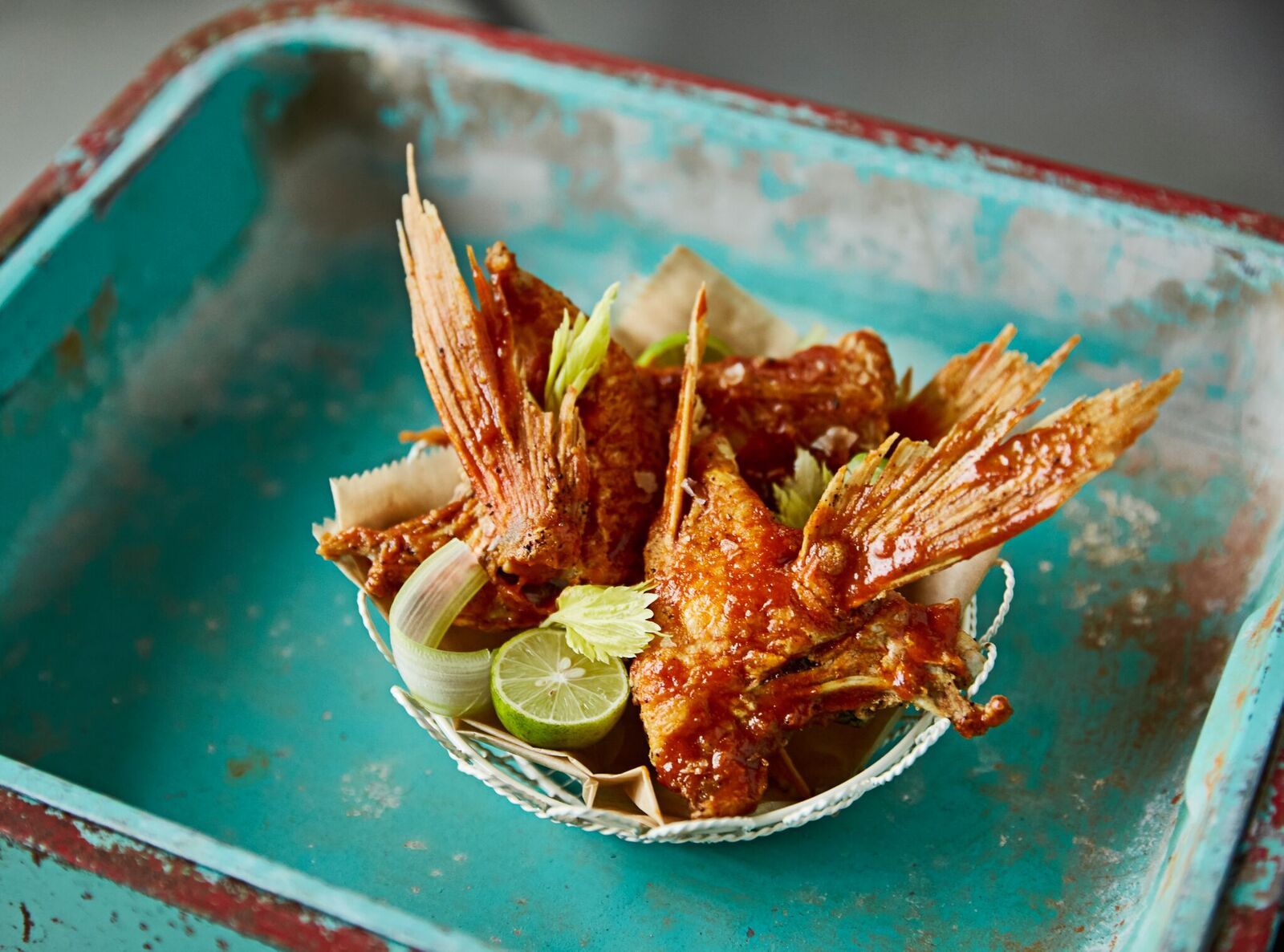 market,
and then preparing it with imagination, even wit.
Exceptionally fine was the “Big Fish for Two”
(market price), on that day a crispy whole snapper
with a lemon-basil salsa verde and a dusting of
Key lime. Every component emphasized the fish’s
freshness, rather than masking it, and cooking it
crisp gave it an extra, highly pleasing texture,
as it also did to crispy coconut shrimp with
roasted coconut, Key lime juice and katafi
pastry around it ($14). They take the idea of
Buffalo chicken wings and re-do it as fish wings (left) with
chili-lime hot sauce and celery hearts ($11).
market,
and then preparing it with imagination, even wit.
Exceptionally fine was the “Big Fish for Two”
(market price), on that day a crispy whole snapper
with a lemon-basil salsa verde and a dusting of
Key lime. Every component emphasized the fish’s
freshness, rather than masking it, and cooking it
crisp gave it an extra, highly pleasing texture,
as it also did to crispy coconut shrimp with
roasted coconut, Key lime juice and katafi
pastry around it ($14). They take the idea of
Buffalo chicken wings and re-do it as fish wings (left) with
chili-lime hot sauce and celery hearts ($11).
The Gulf blue crab cakes
are fat and full of lump meat, served with tangy
pickled kohlrabi and chayote slaw with a semi-hot
horseradish remoulade. All those piquant, savory
flavors coalesce in a way that evokes the sea
smell and taste of the Caribbean. Of course, there
are oysters in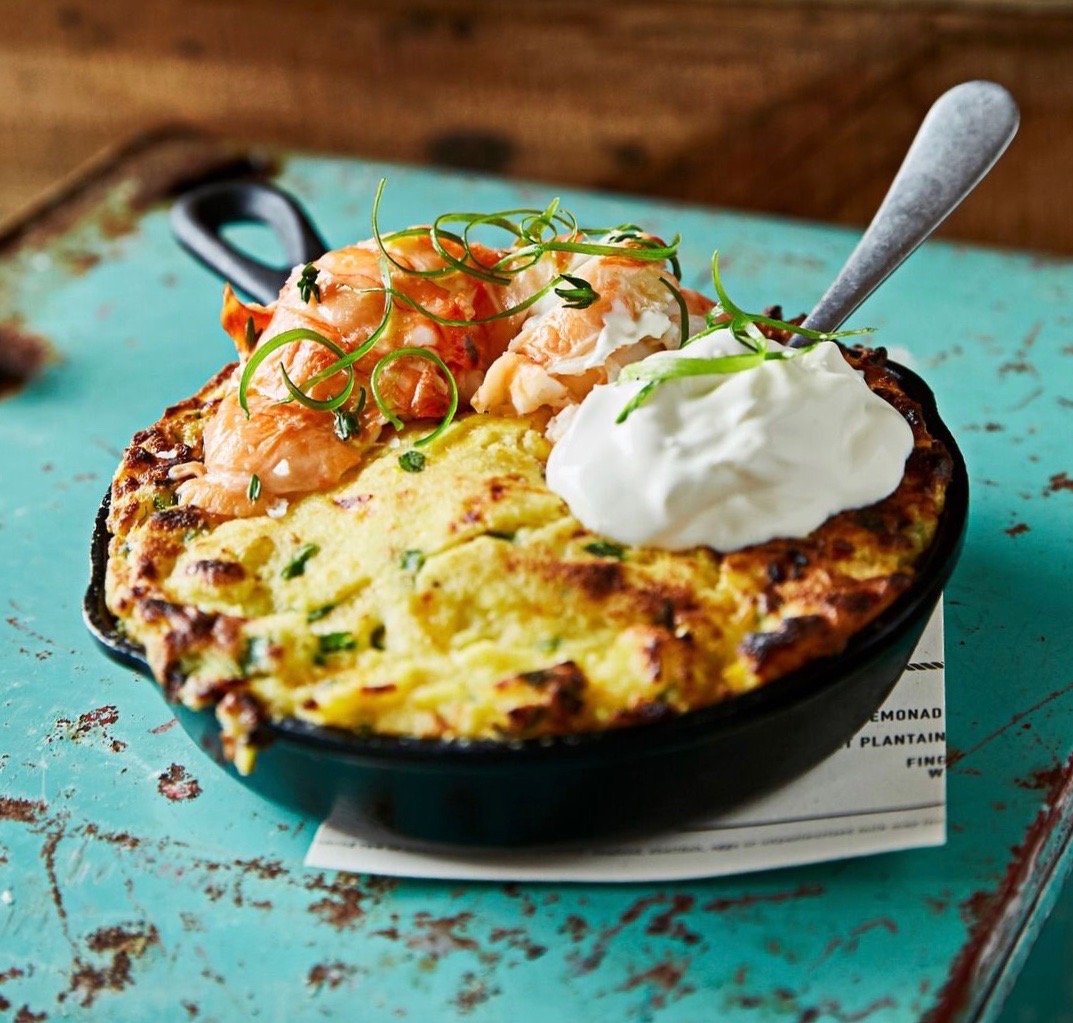 various
forms, not least wood-grilled with charred
sourdough ($18), and a sour orange and red snapper
ceviche ($30) to be shared. The shrimp and
stone-ground grits with Creole sausage, melted
tomatoes, peas and shrimp butte ($27) are a
masterful rendering of this Southern classic.
various
forms, not least wood-grilled with charred
sourdough ($18), and a sour orange and red snapper
ceviche ($30) to be shared. The shrimp and
stone-ground grits with Creole sausage, melted
tomatoes, peas and shrimp butte ($27) are a
masterful rendering of this Southern classic.
Each day, depending on what’s
best, there might be skillet-grilled black grouper
($36), mutton snapper ($34) or other fish. But
don’t neglect the remarkably good fried chicken
with watermelon pickle and hot sauce (half bird
$22). The crusted batter stays on the bird and the
juiciness is evenly suffused throughout.
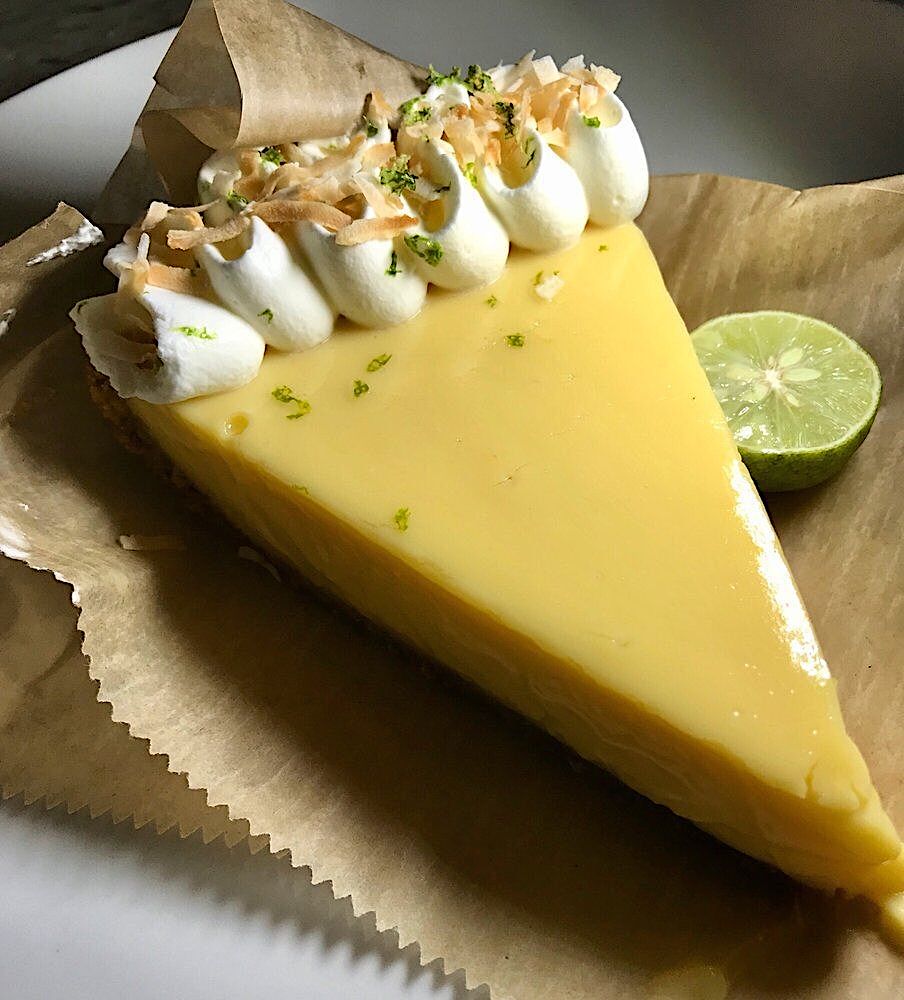 And
definitely do not neglect the sweet cornbread with
buttermilk cream
and scallions, with the option of adding
butter poached lobster ($13). It’s one of my
favorite dishes of the year (right).
And
definitely do not neglect the sweet cornbread with
buttermilk cream
and scallions, with the option of adding
butter poached lobster ($13). It’s one of my
favorite dishes of the year (right).
For dessert as much
attention is shown to that course as the rest, so
you must share a big slice of banana cream pie
served in a jar with a chocolate wafer and toffee
sauce ($10). The sun-bright Key lime pie (left) is just
sour and sweet enough to rank with the best in
Miami.
If Stiltsville were only a
dependable fish house, it would be well worth
going to just to satisfy one’s cravings, but I’d
go back again and again just to see what swam in
the back door that day. I know it’ll be something
I haven’t tasted made so well ever before.
Open
for lunch Mon.-Fri.; dinner nightly; brunch Sat.
& Sun.
BEAKER &
GRAY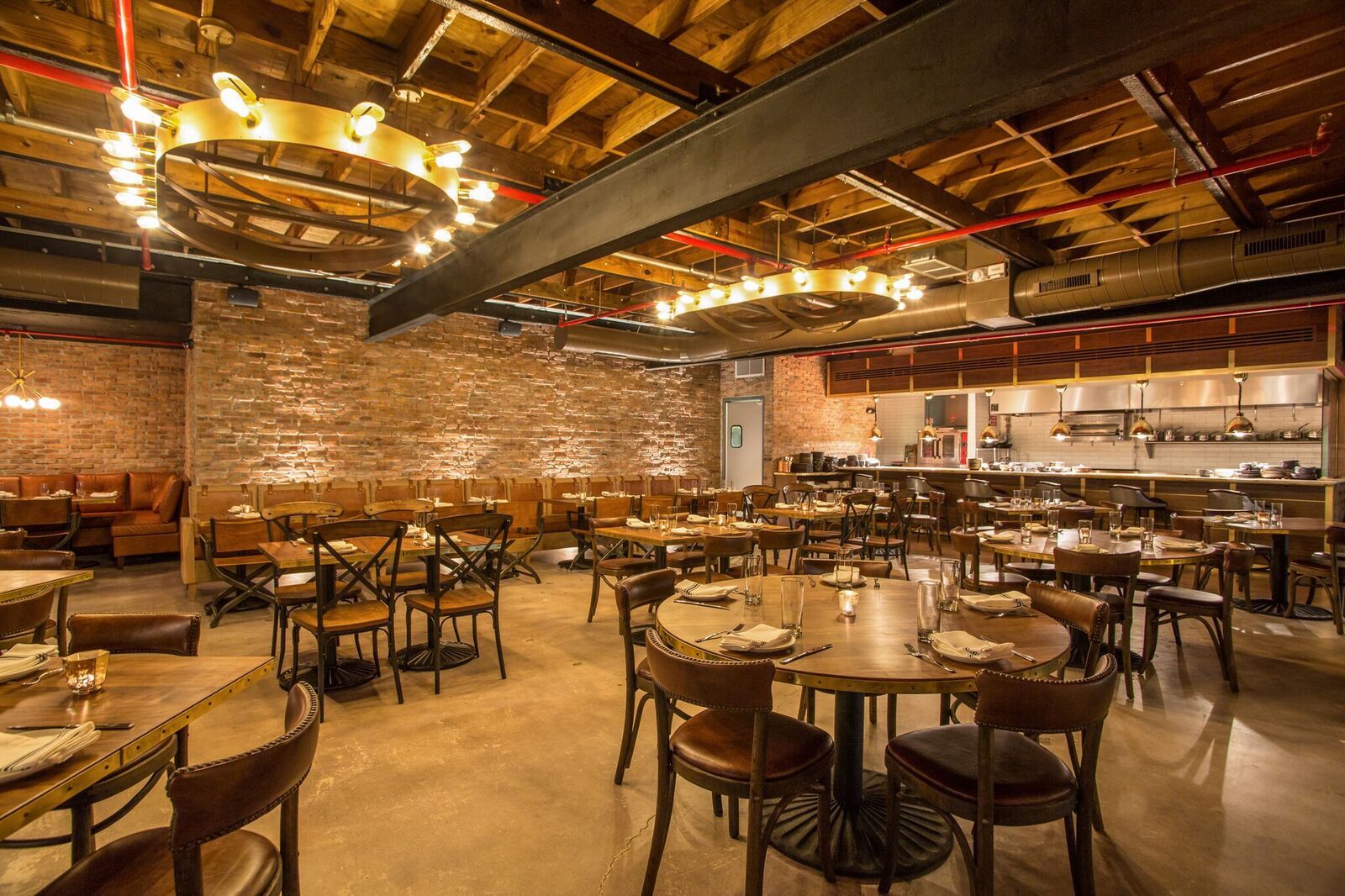
2637 North
Miami Avenue
305-699-2637
I’ll
risk the cliché and call Beaker & Gray the
epitome of the laid-back Florida vibe.
The three-year-old Wynwood Arts
District restaurant opened by Chef Brian Nasajon
is not a kitschy knock-off of a Jimmy Buffet
Margaritaville restaurant serving “Jimmy’s Jammin'
Jambalaya” and “Cheeseburger in Paradise,” but it
does have the look of a bar-lounge that has
unexpectedly good food and a cocktail program
that, under partner Ben Potts, for once really
makes savory sense.
Its wide open
dining room is called an “eatery,” which I’ll
accept along the casual lines and décor of the
place, with its bare wood ceiling and industrial
steel beams, exposed light bulbs, brick walls and
cement floors, folding chairs and straight-backed
banquettes, with a big open kitchen to one side. The
place can get loud, especially with wholly
unnecessary blaring music in the mix of voices
struggling to be heard above it.
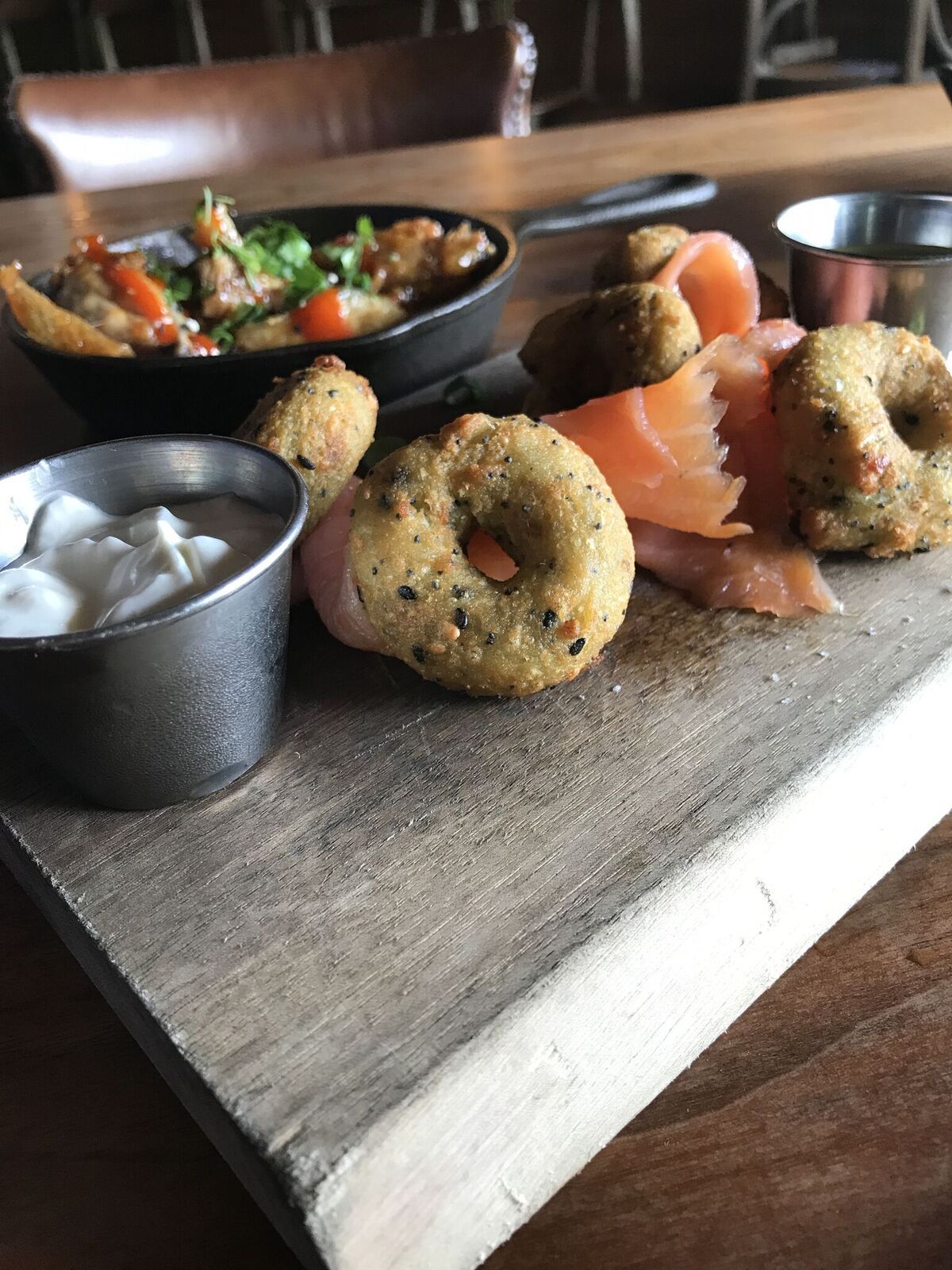 The
waitstaff and manager Reymyl Coleman couldn’t be
friendlier in a way that is clearly genuine and
out to make you have a good time, which will begin
with one of those outstanding cocktails, like the
“Cocoa Boulevardier” made with Wild
Turkey 101 Bourbon, Campari, Cinzano 1757, and
Tuthilltown Cacao.
The
waitstaff and manager Reymyl Coleman couldn’t be
friendlier in a way that is clearly genuine and
out to make you have a good time, which will begin
with one of those outstanding cocktails, like the
“Cocoa Boulevardier” made with Wild
Turkey 101 Bourbon, Campari, Cinzano 1757, and
Tuthilltown Cacao.
Miami native Nasajon’s parents
were from Uruguay, which applaudably affects his
cooking, and a stint at SushiSamba on Miami Beach
gave him his education in handling seafood and
Asian seasonings.
At Beaker & Gray some of the best items
are “Bites,” like the cheeseburger croquettes made
with wagyu beef, aji Amarillo chili, and bacon
($14); an old tiki bar dish made new—and
right—Rangoon crab with cream cheese and shiso
($18); and one of the few bagels I’ve had in Miami
since the closing of Wolfie’s Rascal House that I
really liked, here with “everything” on it (left), Nova
lox, sour cream, onion and dill ($12). Sometimes
more really is more.
Among the hot dishes, the
best I sampled was a platter of short ribs with
pearl onions,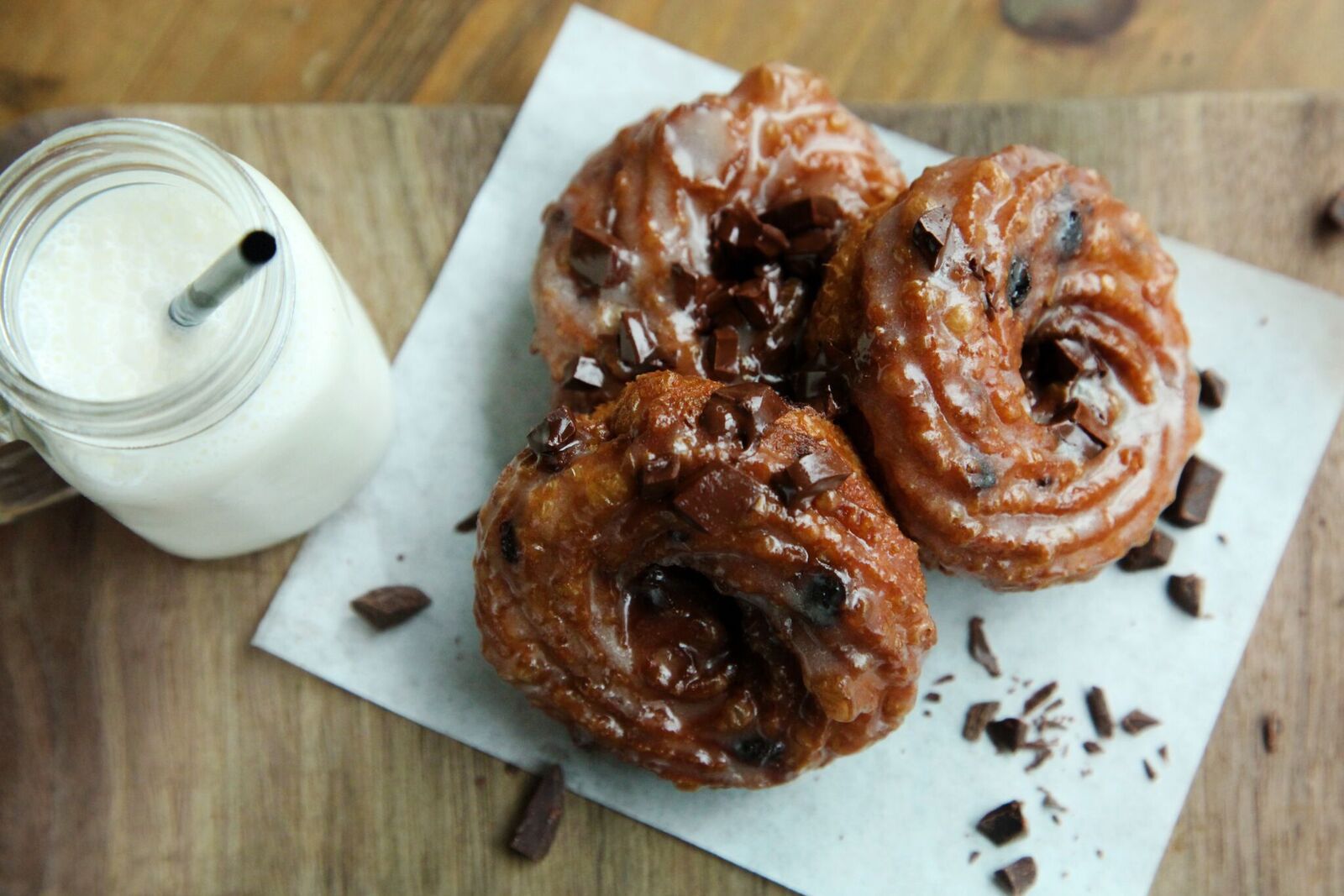 tomato
mustard and a delightful scallion churro ($18).
A yellow curry rice noodle with blue crab and
Chinese sausage was a creditable rendering ($18),
but pumpkin gnocchi with pork rind, manchego
cheese and red shiso was
a bit of a mash up of flavors that didn’t quite
click. ($16).
tomato
mustard and a delightful scallion churro ($18).
A yellow curry rice noodle with blue crab and
Chinese sausage was a creditable rendering ($18),
but pumpkin gnocchi with pork rind, manchego
cheese and red shiso was
a bit of a mash up of flavors that didn’t quite
click. ($16).
What’s not to love about a warm
plate of cookies—or better, chocolate chip cookie
doughnuts with a shooter of rich, creamy vanilla
milkshake ($12)?
There’s also a guava cookie with brown sugar,
guayaba paste and cortadito
coffee ice cream ($11). But the smash hit is
luscious liquid dulce de leche poured over buttery
crumbs with a sugar churro
and sweet cream ice cream ($14). You
should share it; but you may not want to.
Beaker & Gray, along
with MC Kitchen and Michael’s Genuine, pretty much
sums up the current restaurant scene in the Design
District, though there are a lot of upscale chains
said to be opening, like Joël Robuchon’s Atelier
and Jean-Georges Voncerichten’s ABC Kitchen. For me
Beaker & Gray, MC and Michael’s are enough to
keep me well fed and entertained among gallery
visits. Each has that important and credible stamp
of individual personalities and you don’t get that
from chains.
Open for lunch Mon.-Fri.;
dinner nightly; brunch Sat. & Sun.
❖❖❖
Ella
Brennan, Empress of New Orleans’
Restaurant Scene, Dies at 92
By John Mariani

The death of Ella
Brennan—usually referred to as “Miss Ella”—on
Thursday, at the age of 92, will probably be
celebrated in New Orleans with a rousing parade.
In the Crescent City the sadness over someone’s
passing away is always played away by memories of
all the joy a person brought to those who knew her
or knew of her.
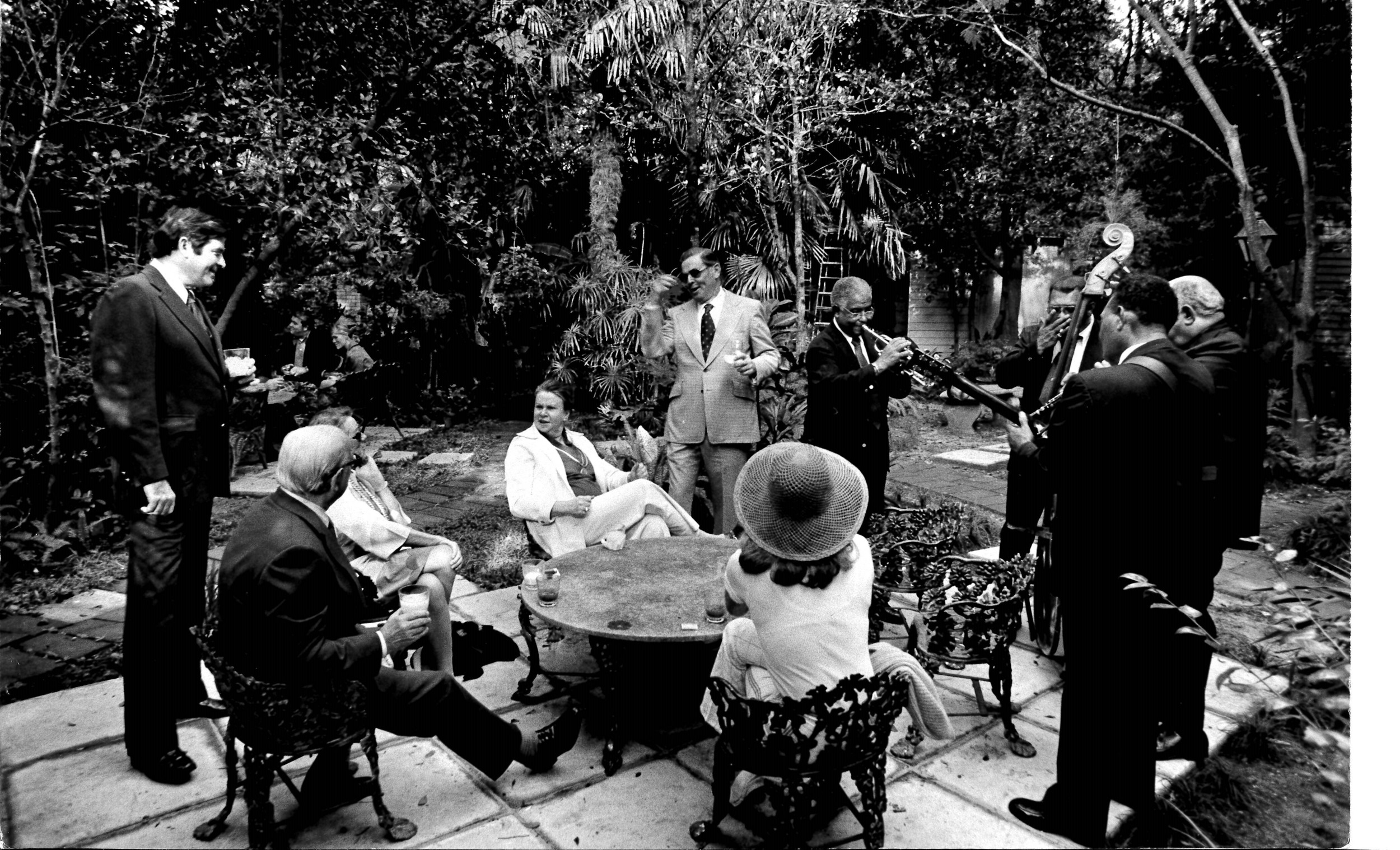 Had she never existed New Orleans
would have been a very different place over the last
century, not just gastronomically but in spirit, for
she was not only the proverbial life of the party
but the materfamilias of New Orleans hospitality. Just by
introducing the Jazz Brunch (left) with her
brother Dick—she said in her 2016 memoir, “I don’t want
a restaurant where a jazz band can’t come
marching through”—she provided a new
spark to somnolent Sundays. And by urging her
chefs—she was never one herself—to create and
refine the regional Creole and Cajun cuisine, she
was in the vanguard of a movement that garnered
her chefs at Commander’s Palace like Paul
Prudhomme, Emeril Lagasse, Jamie Shannon and Tory
McPhail national reputations.
Had she never existed New Orleans
would have been a very different place over the last
century, not just gastronomically but in spirit, for
she was not only the proverbial life of the party
but the materfamilias of New Orleans hospitality. Just by
introducing the Jazz Brunch (left) with her
brother Dick—she said in her 2016 memoir, “I don’t want
a restaurant where a jazz band can’t come
marching through”—she provided a new
spark to somnolent Sundays. And by urging her
chefs—she was never one herself—to create and
refine the regional Creole and Cajun cuisine, she
was in the vanguard of a movement that garnered
her chefs at Commander’s Palace like Paul
Prudhomme, Emeril Lagasse, Jamie Shannon and Tory
McPhail national reputations.
She came, of course, from a famous restaurant
family: Owen Patrick (1886-1958 ) was born in New
Orleans’ “Irish Channel” neighborhood where his
wife Nellie gave birth to Owen Edward, Adelaide, John,
Ella, Dick and
Dottie. The younger Owen early on became primary
support of the family, working as a liquor salesman
and restaurant manager. In 1943 he bought the Old
Absinthe House
on Bourbon Street, then three years later
opened Owen
Brennan's Vieux Carré. With his siblings Adelaide as
bookkeeper and Ella as kitchen supervisor, Owen
worked to make the restaurant one of the most
successful in the French Quarter, and it was said of
him that he could hit someone over the head with his
personality—“a blow from which few tourists,
writers, movie celebrities or presidents ever
completely recovered.” 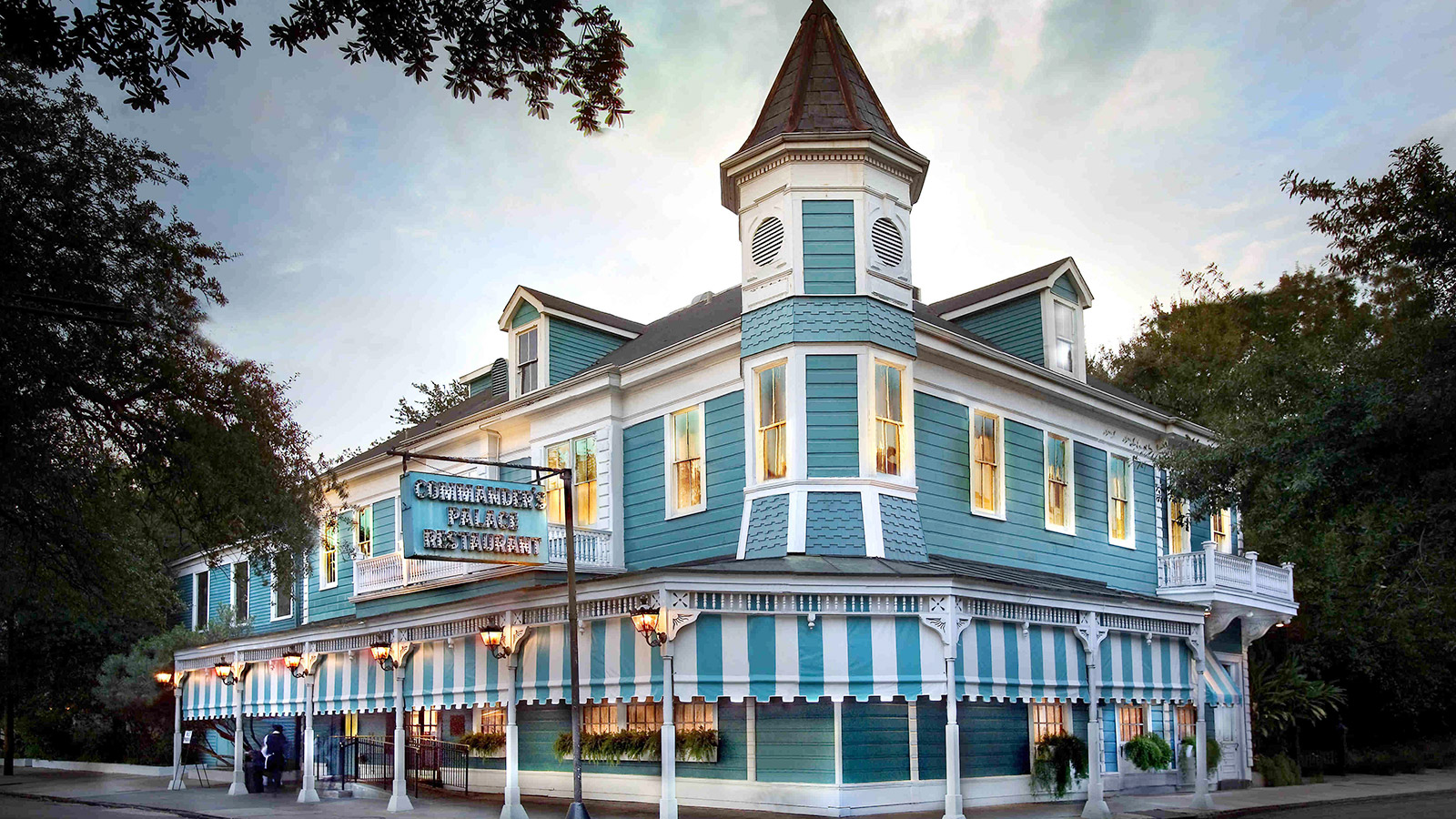
The Brennans moved the
restaurant to 417 Royal Street, where it was to be
called, simply, Brennan’s, though Owen died, at the
age of 45, in November 1955, shy of
the opening of the new restaurant the following
spring. Owing
to various financial considerations, the
restaurant’s interests were split among Owen’s
siblings and his three sons, Owen, Jr., called
“Pip,” Jimmy and Ted.
Under Ella’s urging, the Brennan’s name was
expanded to restaurants in Biloxi, Mississippi, and
Dallas, and in 1969 the family purchased the old
Commander’s Palace (opened by Émile Commander in
1880) in New Orleans’ Garden District.
Difficulties in managing such an empire and
squabbles about how to run the core restaurants
caused a bitter battle among the Brennans; after
months of negotiation the dispute was settled in
November 1973, with Owen’s widow Maude, Pip, Jimmy
and Ted assuming complete control of the flagship
Brennan’s, while Ella, Adelaide, Dick, John, and
Dottie took over Commander’s Palace (above) and the
other Brennan’s restaurants.
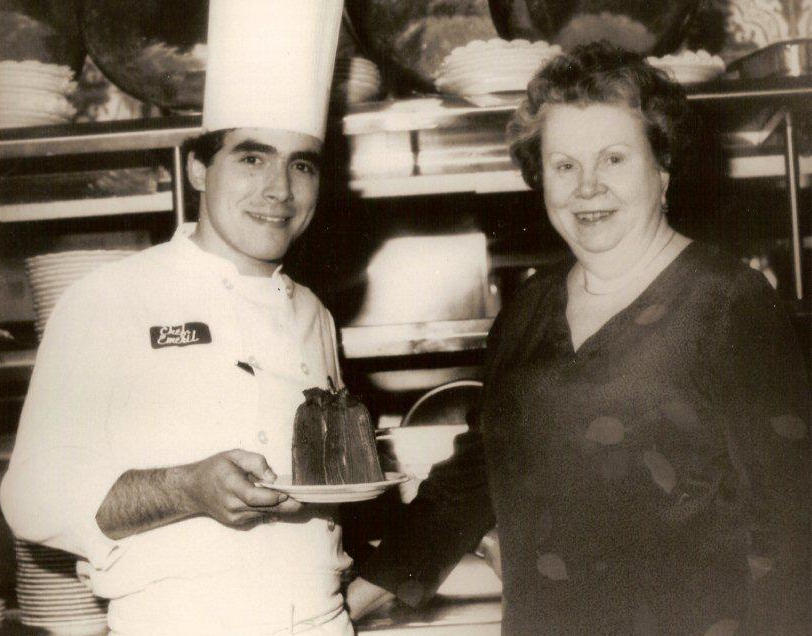 At Commander’s Palace, Ella and
Adelaide were joined by Ella’s daughter Ti and
Lally, daughter of John Brennan, whose other
daughter, Cindy and son Ralph ran
restaurants of their own.
At Commander’s Palace, Ella and
Adelaide were joined by Ella’s daughter Ti and
Lally, daughter of John Brennan, whose other
daughter, Cindy and son Ralph ran
restaurants of their own.
At Commander’s Palace the Brennans began to develop
a style of modern “haute Creole” cooking along the
lines of France’s la nouvelle
cuisine, so that a traditional French or
American dish at Commander’s was said to be
“Creolized.” As
explained by Ella and Dick in their book The Commander’s
Palace New Orleans Cookbook (1984), “In Old
Creole style, everything was cooked for
hours—vegetables and meats were cooked to death. Now
everything is being cooked to order, à la minute,
because we have better ingredients. . . . Perhaps
the most important innovation is in the reduction of
stocks to intensify the flavor of our sauces. . . .
We are also inspired by the burgeoning of small
local producers to take advantage of our local
Louisiana resources.”
Miss Ella with Chef Emeril Lagasse
The Brennans also lifted
standards of service and hospitality to replace the
entrenched, staid attitudes of restaurant workers in
the past, when regular customers were overwhelmingly
favored and newcomers often snubbed.
Ella did intense research on the history of Creole
and French cuisine, butchering, wine, cocktail
making, and service, buoyed by extensive travel
around the U.S. and Europe that gave her a sense of
how the world’s best restaurants were run, an
endeavor she called “restaurant chasing,” often with
her children and siblings in tow. When Ella visited
Danny Meyer’s Union Square Café in NYC, he remarked,
"She was as close as I had seen to an American
version of Queen Elizabeth walking into a
restaurant. She stood proudly and looked around. And there was
just something about her presence that made me stand
at attention with deep respect."
there was
just something about her presence that made me stand
at attention with deep respect."
In 2005 Hurricane Katrina severely damaged
Commander’s Palace and Brennan’s, but both
re-opened. Of
Ella Brennan’s contributions, the on-line site
NOLA.com for the Times-Picayune
wrote, “She used her kitchen at Commander's Palace
as a kind of de facto New Orleans culinary academy,
turning out dozens of the city's finest chefs and
thereby enlivening the local food scene beyond
measure.”
I’m proud to say I knew Ella pretty well, going back
to my first visit to Commander’s in the late 1970s.
Physically
she never seemed to change, maybe a bit more slumped
in recent years but always possessed of a winking
bonhomie. She knew how to flatter and she knew how
to cajole, and she knew how to let the good times
roll, day after day, night after night.
Lally, Ti and
Dottie, with Miss Ella.
I last saw her at her home about
three years ago, and first thing out of her mouth
was, “Y’all want to cocktail?” It was
eleven in the morning.
When people say, “You’ll never
see her likes again,” they’re dead wrong. Various
members of the Brennan clan have carried on her
style and her unique kind of N’awlins exuberance. In a
cocktail party scene in the movie All About Eve,
Bette
Davis barked, “Fasten your seatbelts. It’s going to
be a bumpy night.” That was Ella, and when she was
around, you enjoyed every bump.
By John Mariani
Photos by Paul Johnson
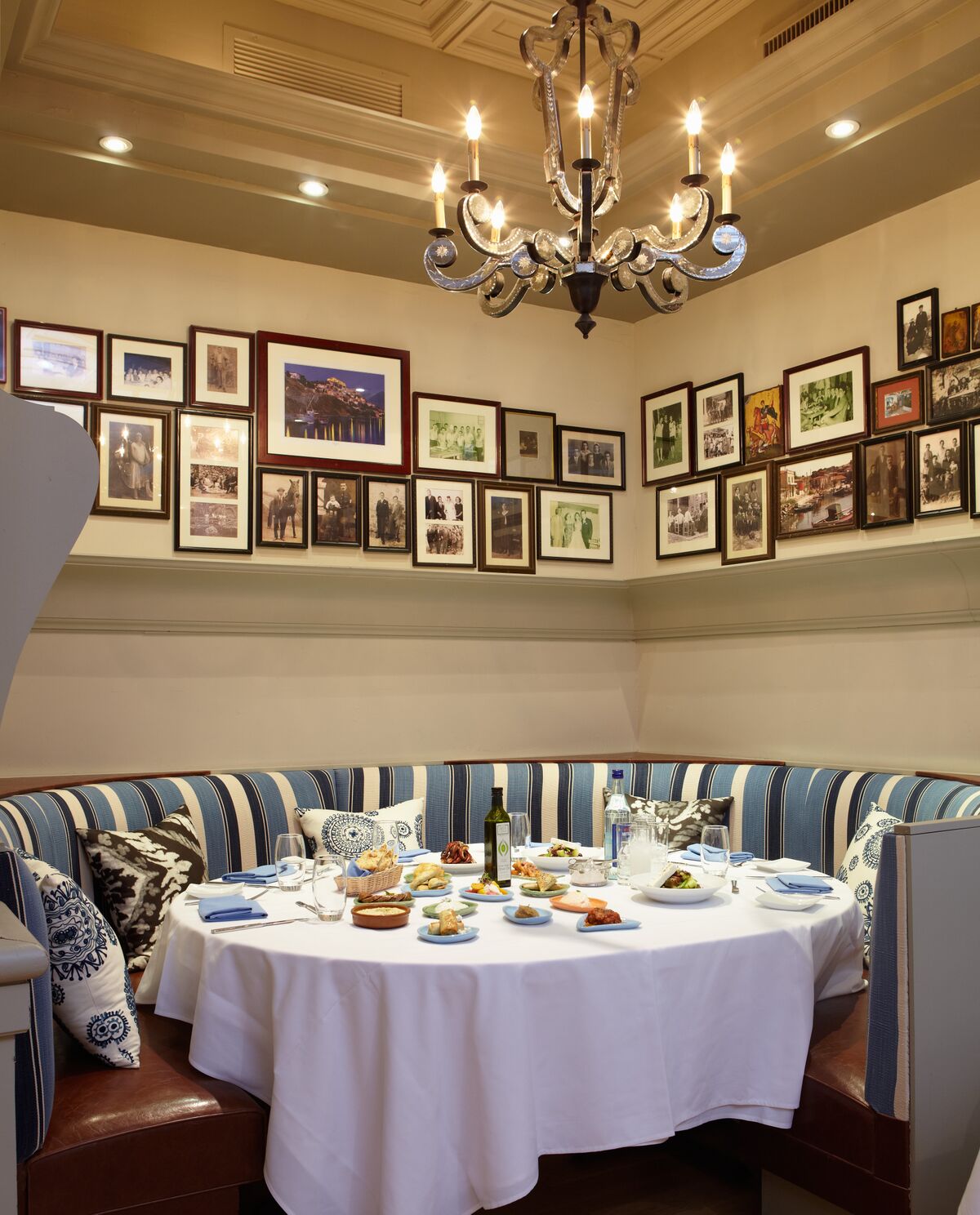 MOLYVOS
MOLYVOS771 Seventh Avenue (near West 56th Street)
212-582-7500
For
more than 20 years now Molyvos, named for a town
on Lesbos, has been one of New York’s most
gregarious and best Greek restaurants, not least
because its rustic décor of warm colors, photos
of the Greek islands and spacious well-set
tables, with a bar (below) that is as much about
eating as drinking. It is all exceptionally
welcoming, but its longevity is owed to its
consistency of Greek cuisine based on high
quality.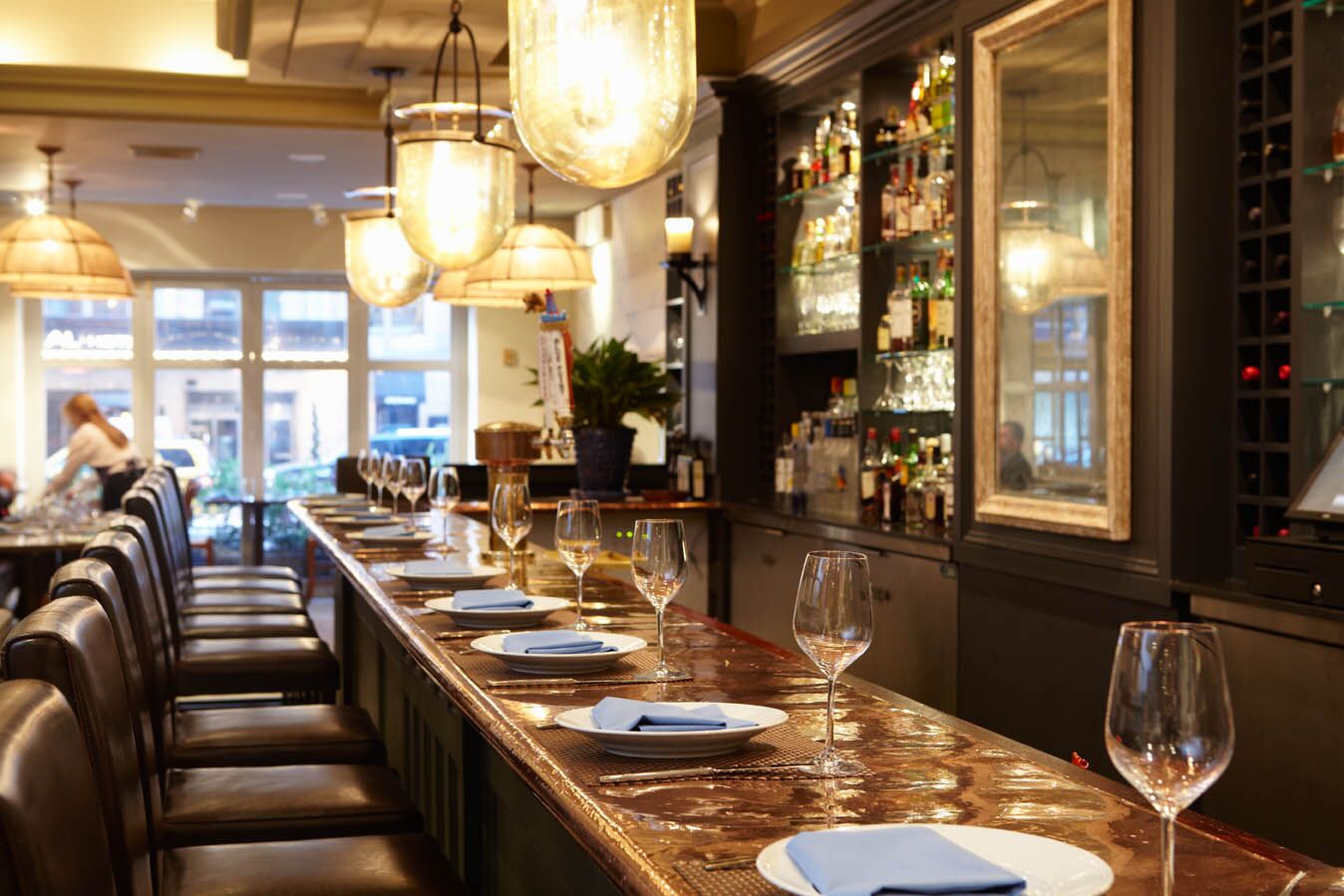
Add to these virtues what is
probably the best Greek wine list in America and a
location one block from Carnegie Hall and the
Theater District, and you have something quite
special, thanks to the Livanos family and partner
Paul McLaughlan, who have kept alive the ideals of
Greek hospitality.
Executive Chef Carlos Carreto
has been there from the beginning in 1997,
learning Greek cuisine from his predecessor, Jim
Botsacos. The menu over two decades has remained
pretty much intact, while the daily whole fish
changes with what is seasonally best in the
market, from black sea bass ($36 per pound) caught
off Montauk, Long Island, to wild lavraki
($36 per pound) from Greek waters. These
are impeccably grilled over charcoal with a fine
searing and interior succulence, dressed simply
with lemon and olive oil.
 Of
course, you’ll want to begin with the Greek mezes spreads
($10 each, or three for $27), from a traditional tzatziki to
a more American avocado-sesame thick with
chickpeas, crunchy pomegranate and Manouri cheese. There
are also eight cheeses available ($8 each, three
for $21). The small plate not to miss is the ikaria
wild greens pie, full of chard, spinach and minted
butternut squash wrapped in crisp pastry ($10).
Roasted beet salad of baby arugula, grapefruit,
yogurt cheese, glazed walnuts and a tangy
Of
course, you’ll want to begin with the Greek mezes spreads
($10 each, or three for $27), from a traditional tzatziki to
a more American avocado-sesame thick with
chickpeas, crunchy pomegranate and Manouri cheese. There
are also eight cheeses available ($8 each, three
for $21). The small plate not to miss is the ikaria
wild greens pie, full of chard, spinach and minted
butternut squash wrapped in crisp pastry ($10).
Roasted beet salad of baby arugula, grapefruit,
yogurt cheese, glazed walnuts and a tangy 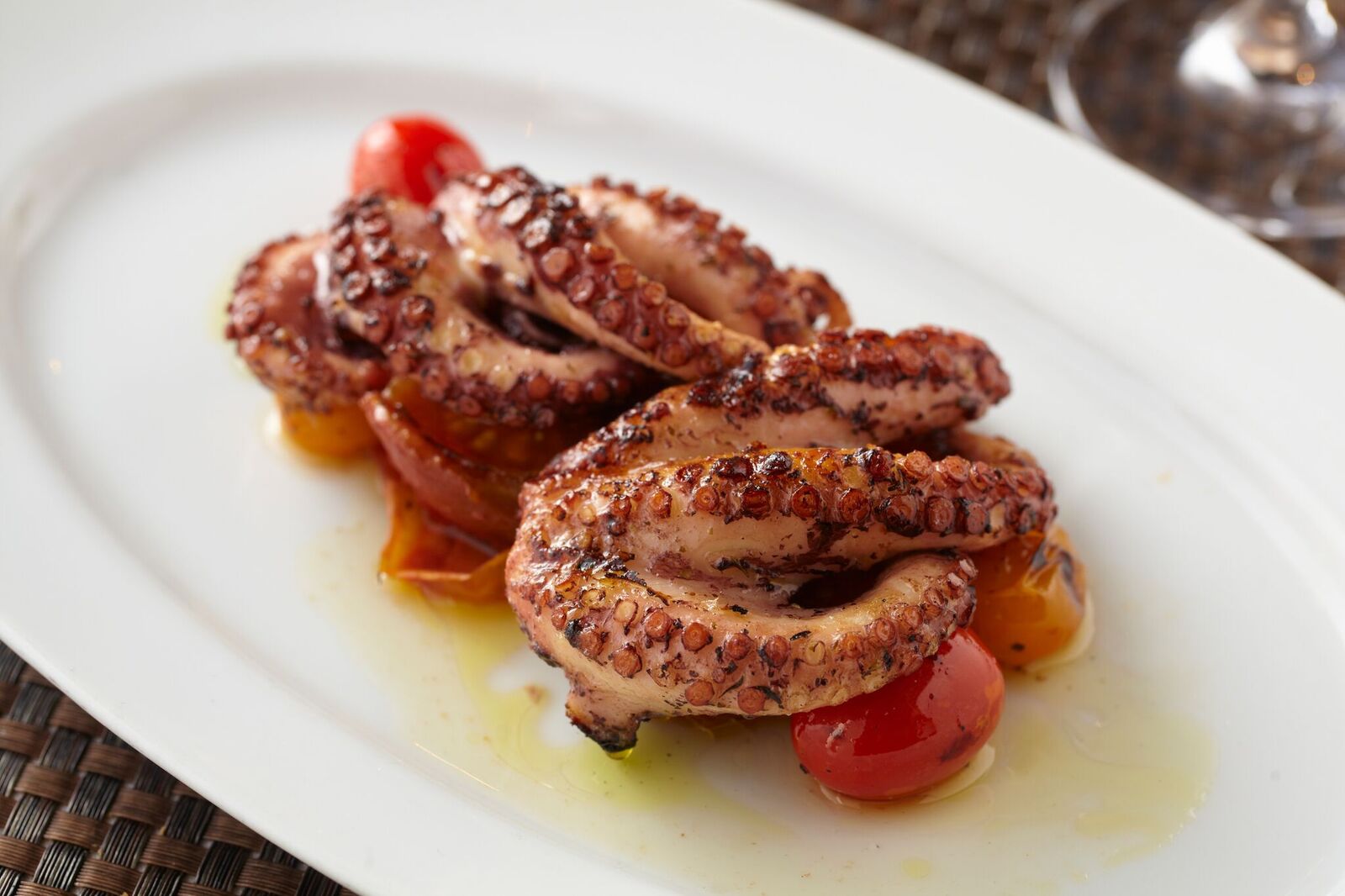 blood
orange vinaigrette ($18) is a refreshing starter,
and the grilled octopus with marinated chickpeas,
baby artichokes, tomato, red onions, celery leaves
and Cretan olive oil dashed with citrus ($24) goes
way beyond the usual platter of naked grilled
octopus.
blood
orange vinaigrette ($18) is a refreshing starter,
and the grilled octopus with marinated chickpeas,
baby artichokes, tomato, red onions, celery leaves
and Cretan olive oil dashed with citrus ($24) goes
way beyond the usual platter of naked grilled
octopus.
The Classics section of the
menu includes a deliciously sloppy stuffed red
pepper with fragrant basmati rice, eggplant,
tomato and Manouri cheese ($25) and a luscious
version of that Greek lasagna moussaka
(below),
lavishly layered with eggplant ($30). For its
entire run Molyvos has served its marvelous, very
tender lamb shank youvetsi with orzo pasta, sweet
tomatoes and Kefalotyri cheese ($30), and they
dare not remove it or change it. It is indeed a
classic rendering.
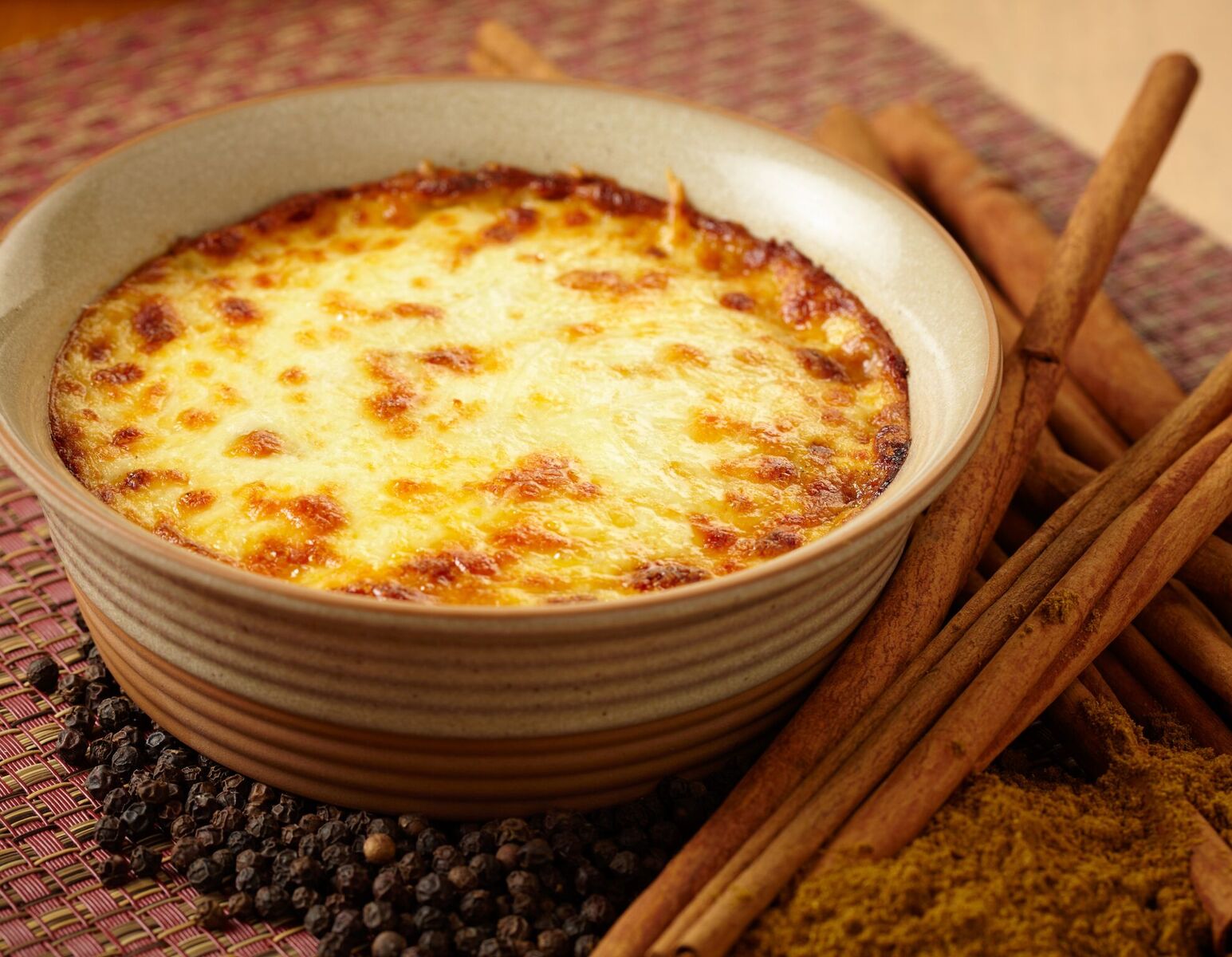 The only
disappointment of the evening were the
lemon-garlic laced potatoes that were roasted too
long so as to become mushy ($12).
The only
disappointment of the evening were the
lemon-garlic laced potatoes that were roasted too
long so as to become mushy ($12).
The baklava sampler ($12) is
the wisest option for dessert, offering you
chocolate-almond-prunes, hazelnut, or white
chocolate tres leches. But an option is the chocolatina
($12), a rich mousse cake with orange flavorings
and melting vanilla ice cream. I was
surprised, then, that the Greek coffee I ordered
was thin and watery, when it should have been
thick and syrupy.
As noted, the wine list is a
marvel—page after page of modern Greek wines from
Santorini, Thessaly, Macedonia and more. The rosés
are of particular interest for the summer.
It
would be nice to see Molyvos add more new dishes
of a kind one now finds at a more modern Greek
restaurant like Nerai on the East Side, but what
you enjoyed at Molyvos in the past will be every
bit as delicious the next time you go, and once
experienced, you’ll find it difficult not to
return to this joyful restaurant for what will
become your personal favorites.
Lunch
and dinner daily.
❖❖❖
IS NOT CHAMPAGNE
By John Mariani
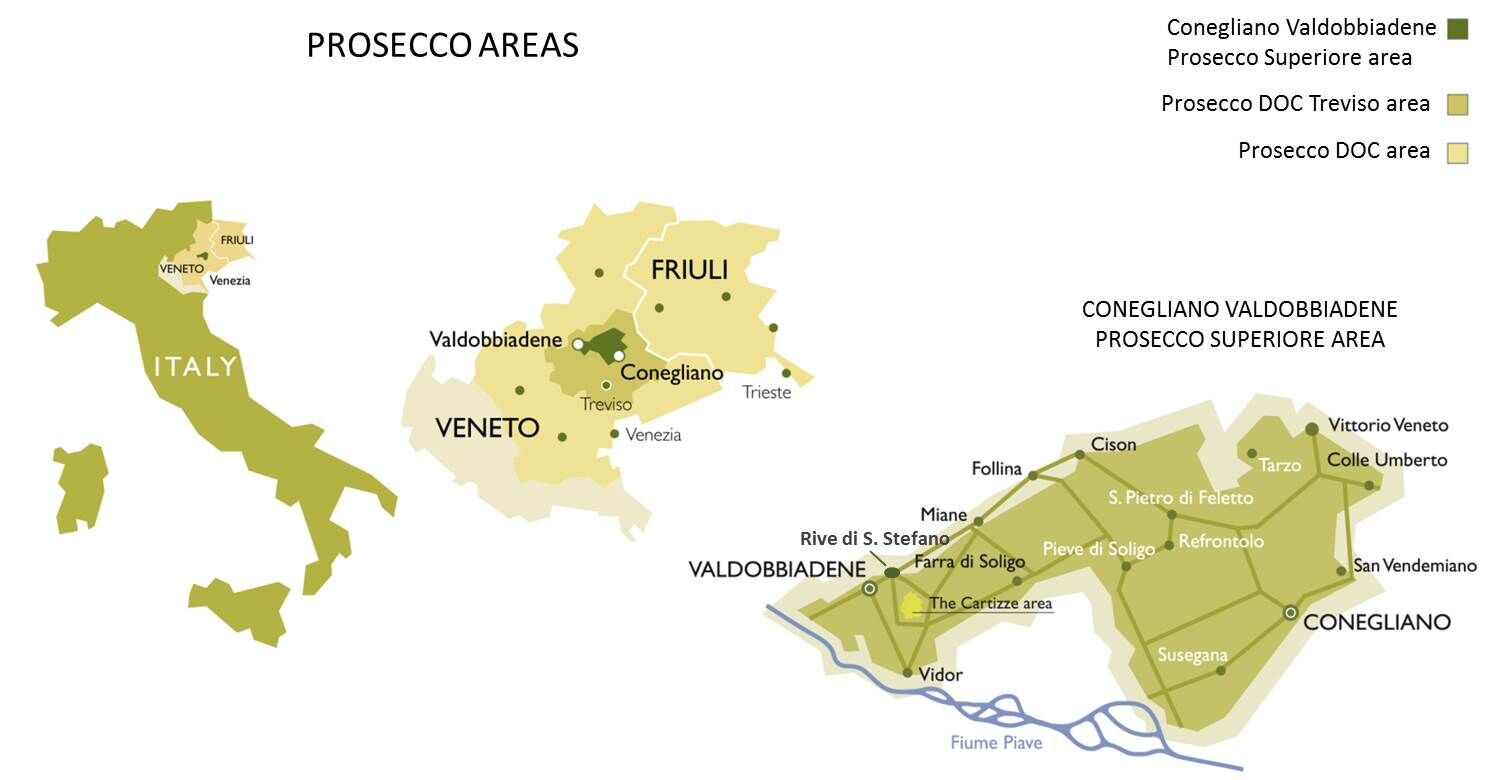
Twenty
years ago if you heard at all about Prosecco,
the white sparkling wine from Italy’s Veneto
region, it was probably as a component with
white peach juice of the bellini cocktail,
invented at Harry’s Bar in Venice. 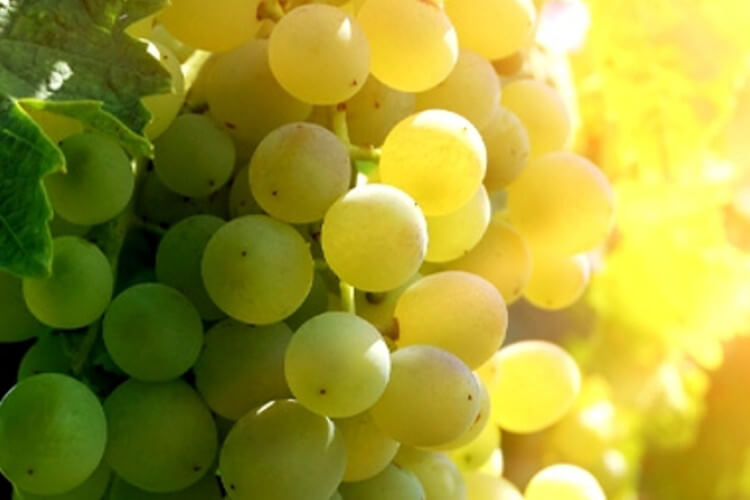 The
popularity of that easy-to-drink apéritif helped
Prosecco get a foothold in the U.K., German and
U.S. markets as a good mixer as well as a cheap
alternative to Champagne.
The
popularity of that easy-to-drink apéritif helped
Prosecco get a foothold in the U.K., German and
U.S. markets as a good mixer as well as a cheap
alternative to Champagne.
Unfortunately, Prosecco’s
increasing popularity led to the export of
enormous amounts of very poor, very cheap, very
watery Prosecco, with only a few labels like
Bisson, Valdo, Bortolin, Ruggeri and Mionetto
producing high quality examples, whose prices were
modestly higher than poor examples and a lot lower
than Champagne.
Since the 19th century
Prosecco, largely from the grape of the same name
(though in 2009 the grape was re-designated as
Glera, left),
has been made according to the French Charmat
method (called “martinotti” in Italy), by which
the second fermentation takes place in a pressure
tank. This is faster and much cheaper than the
complex méthode champenoise by which the second
fermentation, after the addition of a sugar liquid
called the dosage,
is done in the bottle.
But,
despite Prosecco sales soaring over the past
decade and expected to increase by 36% in the next
five years with a 9.2% share 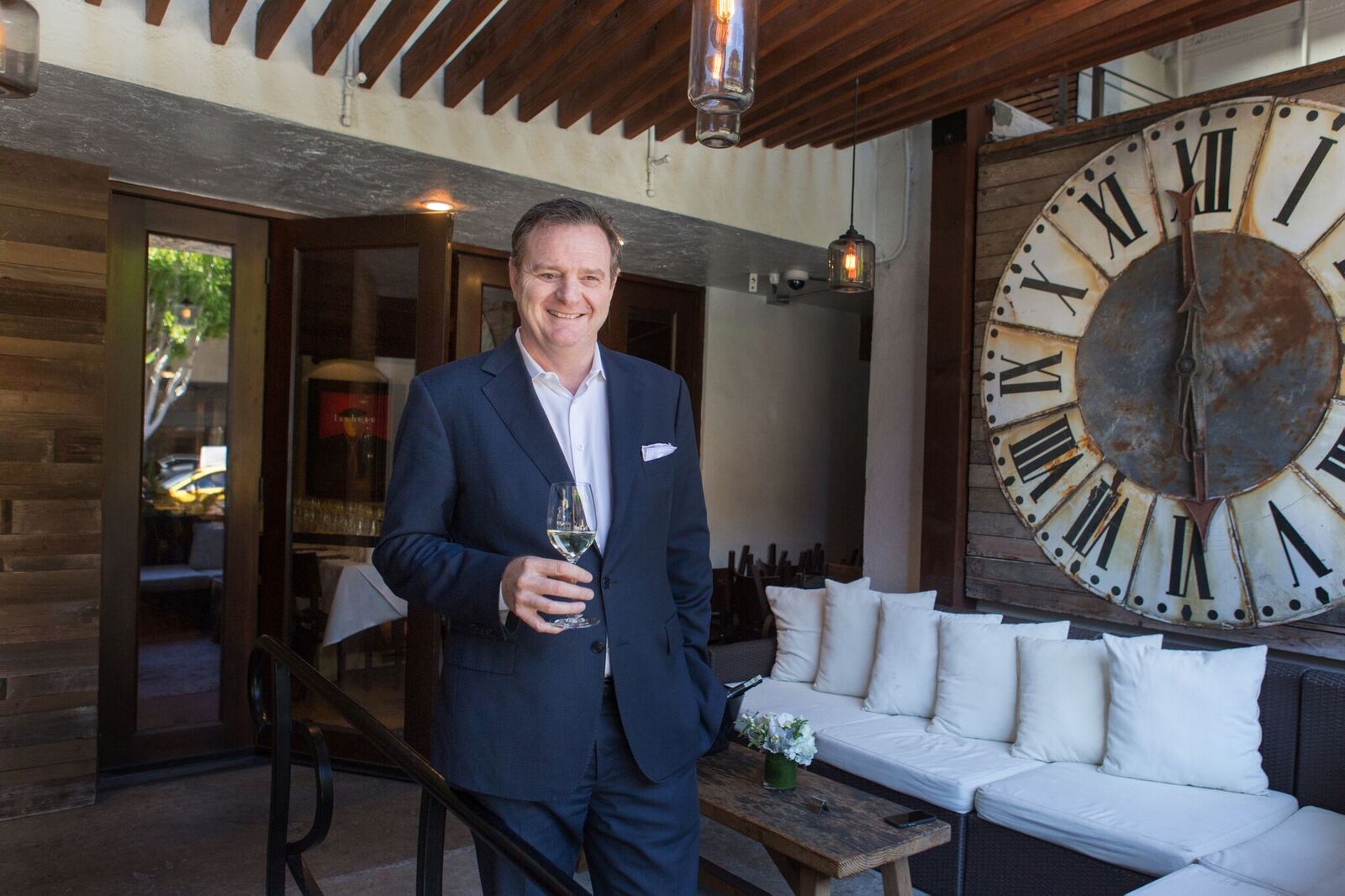 of the
global wine market and accounting for 20% of all
sparkling wine sales, the wine has remained in the
shadow of the more illustrious name of Champagne,
which makes Enola Ceola, CEO-Managing Director of
Mionetto USA, shrug.
of the
global wine market and accounting for 20% of all
sparkling wine sales, the wine has remained in the
shadow of the more illustrious name of Champagne,
which makes Enola Ceola, CEO-Managing Director of
Mionetto USA, shrug.
Over dinner near his office in
White Plains, N.Y., I asked him about raising the
image of Prosecco vis-à-vis Champagne.
“We raise the image of Prosecco by
saying it is not
Champagne,” he said, pouring the company’s
flagship DOC Treviso Brut ($14) with its orange
label (which does resemble Veuve Clicquot’s). “For
a lot of people Champagne is intimidating and a
special occasion wine. We market Prosecco as an
everyday indulgence.”
Clearly the price of Prosecco
is a powerful factor in promoting Ceola’s point of
view. Many Proseccos sell in the U.S. for under
$10, and bars and restaurants sell them for
$10-$12 a glass—-far below any entry level
Champagne. Boston’s Lincoln Tavern sells 1,000
cases a year and New York’s Grand Tier at the
Metropolitan Opera in Lincoln Center pours
all-you-can drink Mionetto as part of its Sunday
brunch.
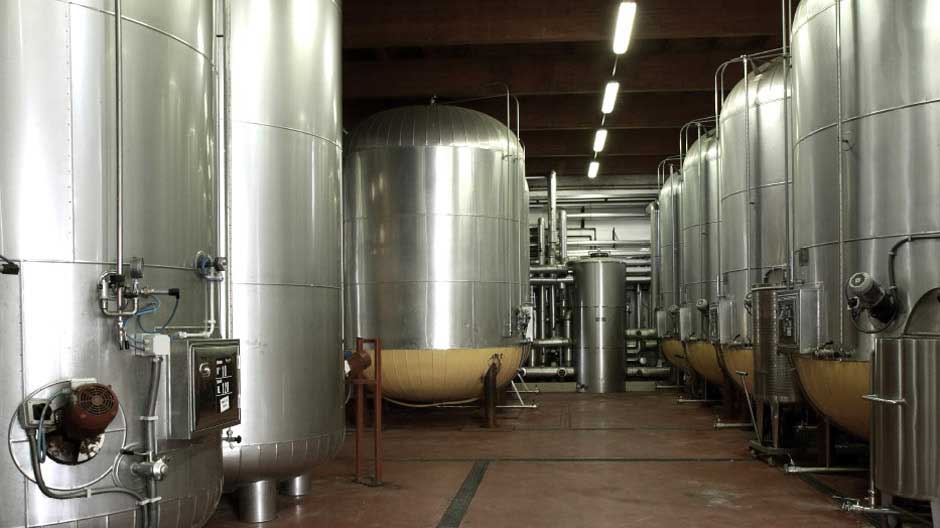 Being cheap, however,
has kept Prosecco’s image low, which is what Ceola
is committed to changing. “There is, sadly, a lot
of poor Prosecco in the market,” he said. “They
suffer from too high a yield and overproduction.
That’s why many have a bitter aftertaste. You can
make a bellini with them but you wouldn’t want to
sip it as an apéritif or throughout a meal.”
Being cheap, however,
has kept Prosecco’s image low, which is what Ceola
is committed to changing. “There is, sadly, a lot
of poor Prosecco in the market,” he said. “They
suffer from too high a yield and overproduction.
That’s why many have a bitter aftertaste. You can
make a bellini with them but you wouldn’t want to
sip it as an apéritif or throughout a meal.”
Mionetto’s prices in U.S. wine
stores range from about $10 up to $35, and while
there is no fear that it will run dry, the company
has diversified its labels while staying true to a
style that aims for a balance of alcohol, acidity,
fruit and yeast, with very fine bubbles. “We are
very thoughtful about how much dosage
our wines contain,” said Ceola. “We make some of
our wines without any at all,” referring to its
limited edition Millisimato label.
Under Italian wine laws Prosecco’s sweetness varies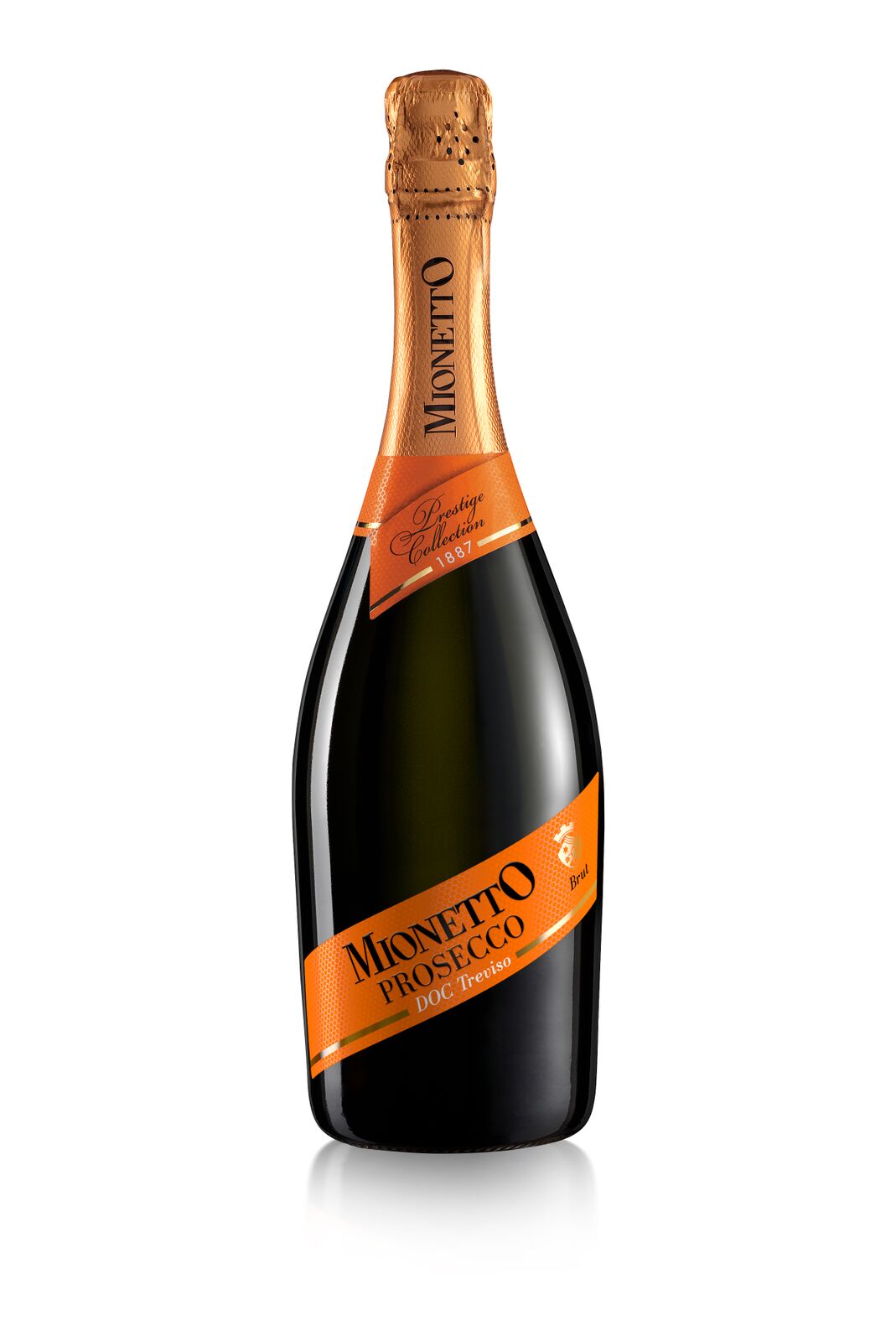 based on
the sugar levels remaining after fermentation:
Extra Brut contains under 6 grams of sugar per
liter; Brut 6-15 grams; Extra Dry 12-20
grams; Sec or Dry 9-35 grams.
based on
the sugar levels remaining after fermentation:
Extra Brut contains under 6 grams of sugar per
liter; Brut 6-15 grams; Extra Dry 12-20
grams; Sec or Dry 9-35 grams.
Mionetto
was founded in 1887 (since 2008 owned by Germany’s
Henkell & Co.) in the Valdobbiedene region
north of Venice, and up until a month ago the
company bought all its grapes from growers with
whom it has developed long-term relationships
(“mostly on handshakes,” says Ceola). The company
recently bought its first vineyard land, 200
acres, which in the best sections of the DOCG
region is going for more than 1 million euros
($1.17 million) an acre. Ceola noted that “Growing
Prosecco grapes used to be a second job for a lot
of people in the region, who just did it on
weekends and made a little money. Now
those farms are worth a fortune, and the growers
are going more full-time.”
Proving that Prosecco is
actually very appealing throughout a meal, I
tasted several Mionetto sparklers with dishes as
varied as yellowfin tuna crudo,
pizza with Italian sausage, gnocchi
with a mushroom cream sauce, salmon with quinoa,
and Parmesan-crusted halibut.
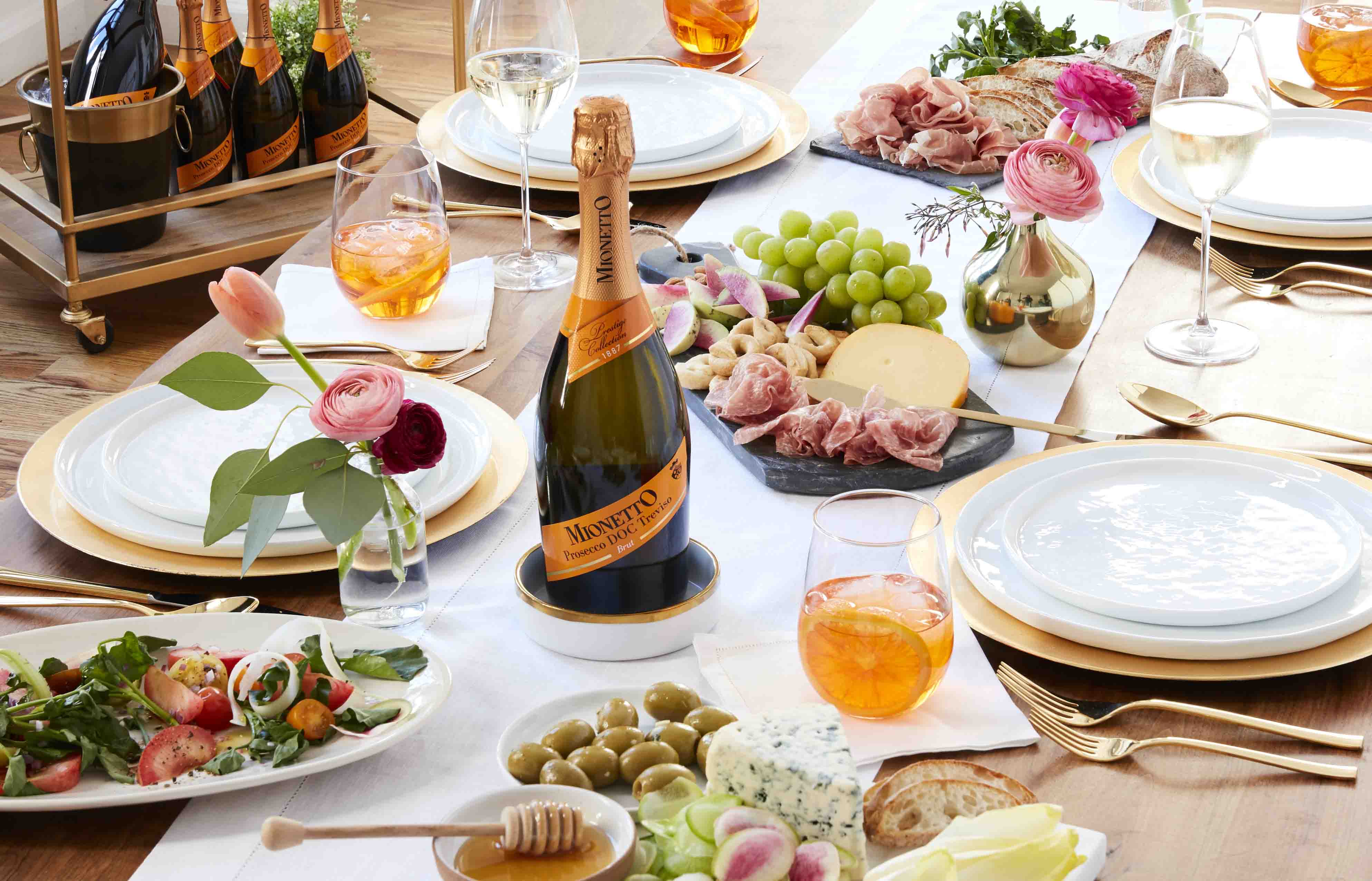 To celebrate its history
Mionetto did a limited release Valdobbiadene Prosecco Superiore
DOCG Millesimato Brut Nature ‘Cuvée Anniversario’ ($25)–-quite
a mouthful, literally and figuratively—from
selected, hand-harvested grapes, a prolonged rest
on the lees, and no dosage
that is indeed beautifully balanced and has far
more fruit flavor than comparable bubblies with no dosage.
To celebrate its history
Mionetto did a limited release Valdobbiadene Prosecco Superiore
DOCG Millesimato Brut Nature ‘Cuvée Anniversario’ ($25)–-quite
a mouthful, literally and figuratively—from
selected, hand-harvested grapes, a prolonged rest
on the lees, and no dosage
that is indeed beautifully balanced and has far
more fruit flavor than comparable bubblies with no dosage.
The company’s most
prestigious—and at $35 its most expensive—is the
elegant Cartizze DOCG Dry, whose grapes come from
the most renowned vineyards in Veneto, picked in
the second half of September, and bottled at 11%
alcohol and 24-26 grams of sugar per liter. This
is a creamy, luscious Prosecco whose faint
sweetness makes it perfect with something like
prosciutto and melon, sole in lemon butter and
Italian cheeses like Parmigiano, Robiola, even
Gorgonzola.
I mentioned
to Ceola that some prestigious Champagne houses
are now promoting their lower-priced sparklers to
be poured over ice cubes in summer. Ceola laughed
and said, “We’ve already done that with our Il
Collezione line. See, Champagne is now trying to
compete with Prosecco!”
 DULLEST OPENING LINE
DULLEST OPENING LINE OF THE MONTH
"In case you're one of the few who haven't heard: Florida is one popular place for visitors."--Michael Candelaria, "An Ideal Climate," Delta Sky (May 2018).
GUESS
WHAT THE "PU" STANDS FOR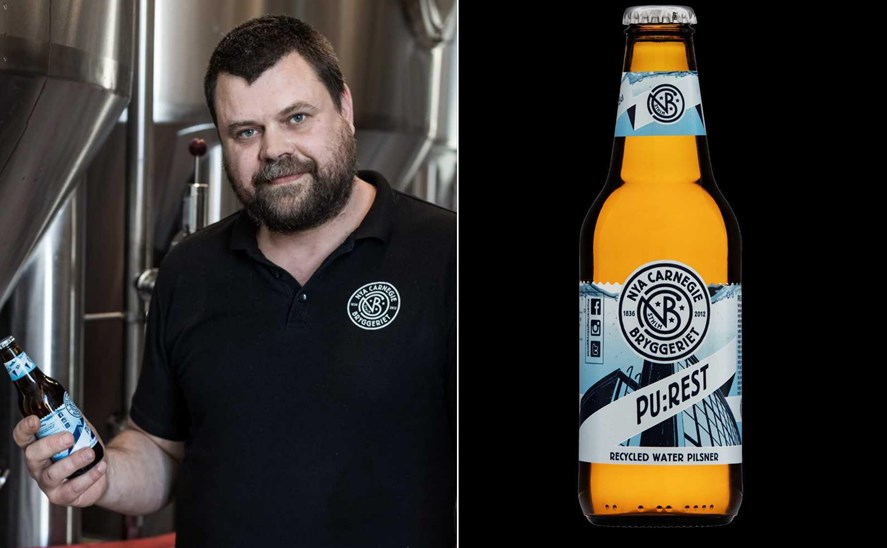
Swedish brewery Nya Carnegiebryggeriet,
Carlsberg, and the Swedish Environmental (IVL) have
launched a new pilsner brewed with recycled
wastewater, called PU:REST, in an effort to raise
awareness for sustainable, safe drinking water. As
brewmaster Chris Thurgeson (right) said, “We share the view that
both producers and consumers must dare to think
differently if we are to successfully take care of
Earth’s resources."
Wine
Column Sponsored by Banfi Vintners
SANGIOVESE
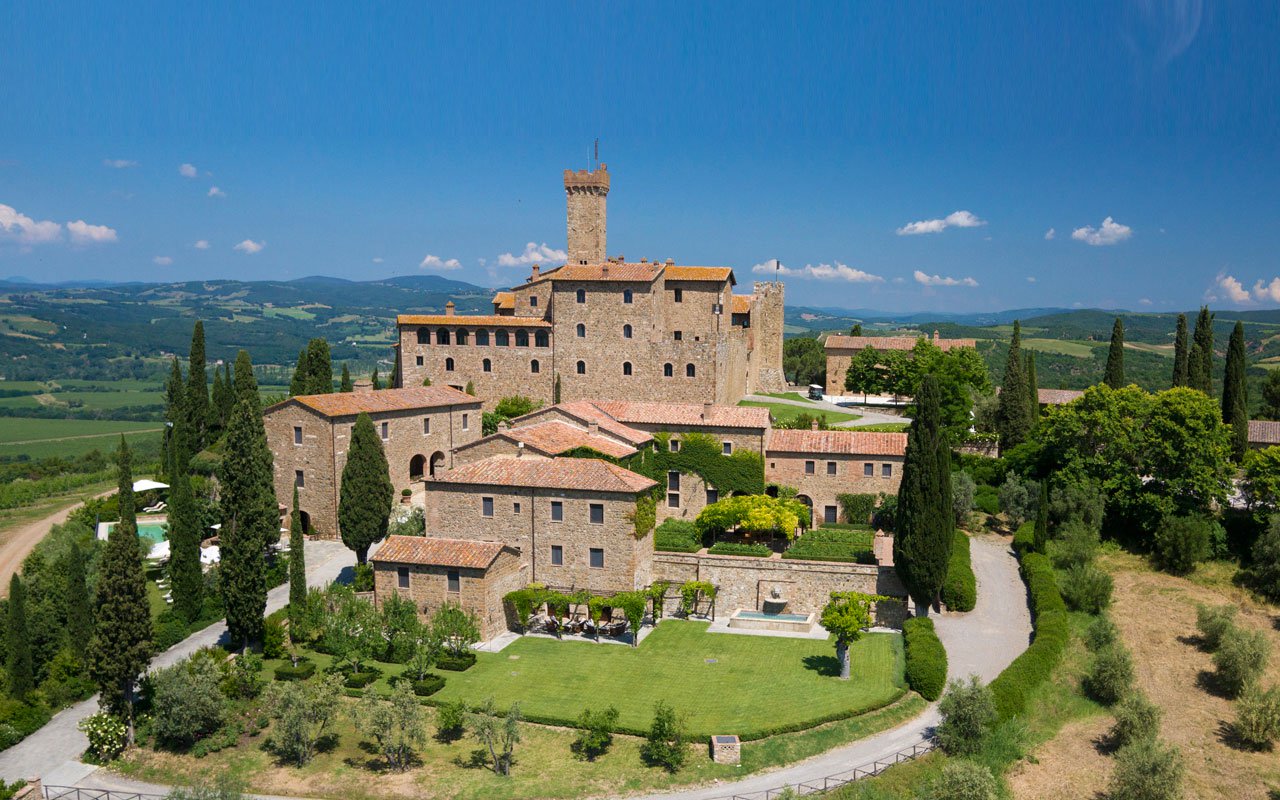 Wine is a joy year-round but
in cooler weather one
grape varietal has really taken center stage in
my daily activities – that most Italian of
grapes, Sangiovese, and its ultimate expression
– Brunello di Montalcino.
Wine is a joy year-round but
in cooler weather one
grape varietal has really taken center stage in
my daily activities – that most Italian of
grapes, Sangiovese, and its ultimate expression
– Brunello di Montalcino.
From mid-September through mid-October,
the Sangiovese grown for our various styles of red
wines are be harvested, culminating with the top
selection for Brunello di Montalcino.
Second, cooler weather here means
it is time to start enjoying more red wines and
especially Sangiovese based wines. That
includes Banfi’s cru of Brunello, Poggio alle Mura,
literally the cream of the crop of our Sangiovese
vineyards. Alongside our Poggio alle Mura Brunello di
Montalcino, this year we introduced two more wines
from the cru Poggio alle Mura – a Rosso di Montalcino
and a Riserva of Brunello. Rosso is sort of like the
younger brother of Brunello, also made from 100%
Sangiovese grapes but usually a selection from younger
vines and the wine is aged only two years compared to
the four required for Brunello. The
Riserva, on the other hand, is an even more selective
harvest of Sangiovese, and ages for an additional year
before release.
What is so special about this cru
Poggio alle Mura?
Well, it is the result our over 30 years of
ongoing research at my family’s vineyard estate,
Castello Banfi.
When we first began planting our vines there in
the late 1970s studies from the University of Bordeaux
indicated which strains of many varietals we should
plant, based on the soil type and microclimate of each
vineyard. But
when it came to the region’s native Sangiovese, there
was only local lore, no scientific research. So we took
it upon ourselves to figure out this vine, and set off
on three decades of incredibly detailed research.
We started
with 600 apparent variations on Sangiovese, because it
is so susceptible to variations in weather and soil,
and narrowed that down to 160 truly genetically
different clones.
We planted a vineyard with two rows of each
type, made wine from each of them, and charted the
differences – remember, you only get one chance a year
to make wine, so this took time.
It took about ten years to get some
concrete results, though we continue to experiment
today and always will – you never stop learning in
science and nature!
Once we determined which were the best,
complementary clones that could be planted together to
make the best Brunello, we chose to plant them in what
we determined to be the optimal vineyard sites. Coincidentally,
the best soils and climate conditions are in the
slopes surrounding the medieval fortress today known
as Castello Banfi, known since Etruscan times as
Poggio alle Mura – the walled hilltop. Hence the
name of our most special “cru” of Brunello,
representing a synthesis between tradition and
innovation.
Though the focus of this study was
our Brunello, all of our Sangiovese-based wines,
including the super Tuscans SummuS, Cum Laude, and
Centine, benefitted from this work. And that’s
the third reason for celebrating Sangiovese this
month, for the range of wonderful reds that usher us
into autumn! One
wine in particular was inspired by our research – the
BelnerO, a Sangiovese dominant blend with what I like
to call a kiss of Cabernet and a whisper of Merlot. We grow the
grapes a little differently for BelnerO than for
Brunello, make the wine with less oak aging and
released it earlier from the winery, providing a
counterpoint to Brunello and a lovely terroir-driven
wine in its own right.
If you
know Italians, you know that by nature we are
multi-faceted, varying in mood, and always passionate. As a
nation, we span from the hot sunny beaches of Sicily
near the African coast to the rugged mountains and
Alpine ski slopes of Trentino-Alto Adige in the north. Sangiovese
is grown in almost all of Italy’s regions and reflects
the unique nature of each; it is most famous
(rightfully so) in Tuscany, yet even there it reflects
the nuances of each hilltop, valley and subzone. It has
something a little different to say in Brunello than
Chianti, Morellino than Vino Nobile di Montepulciano,
Rosso di Montalcino than Super Tuscan blends.
Here is a smattering of
Sangiovese-based wines that you may wish to get to
know better, reflecting a spectrum that appeals to
every occasion, every taste, and every budget. We can
assure you that the conversation will never become
boring. 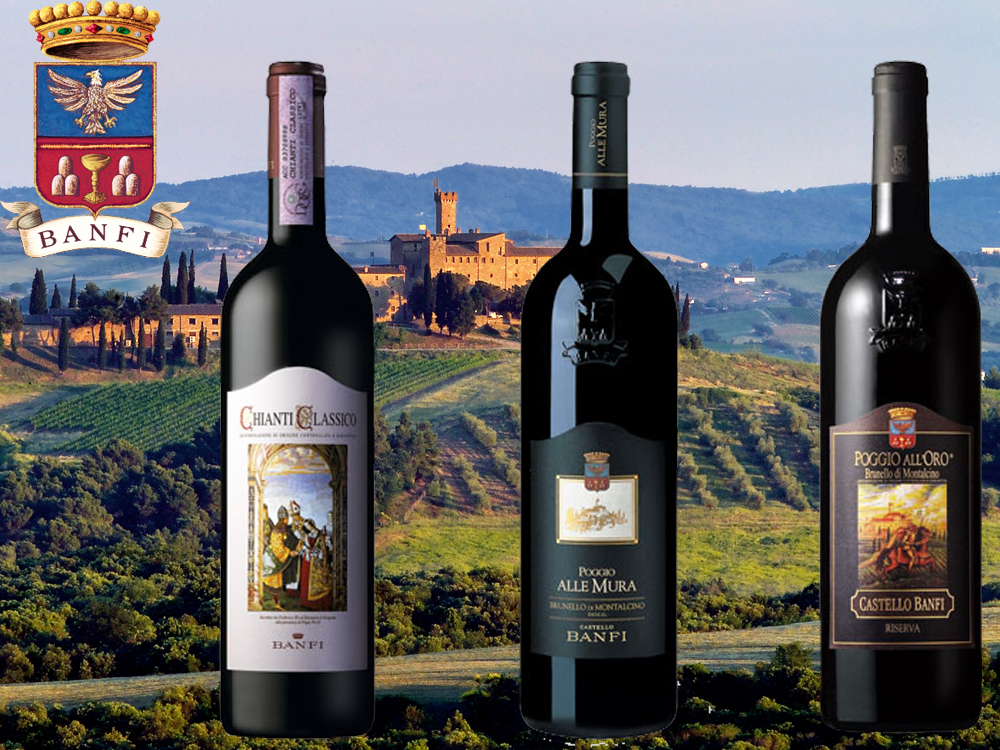
Recommendations for Celebrating
Sangiovese
BelnerO Proprietor’s Reserve Sangiovese
– A refined
cuvée of noble red grapes perfected by our pioneering
clonal research. This dark beauty, BelnerO, is
produced at our innovative winery, chosen 11
consecutive years as Italy’s Premier Vineyard Estate.
Fermented in our patented temperature controlled
French oak and aged approximately 2 additional years.
Unfiltered, and Nitrogen bottled to minimize sulfites.
Castello Banfi Brunello di Montalcino –
Rich, round, velvety and intensely
aromatic, with flavor hints of licorice, cherry, and
spices. Brunello di Montalcino possesses an intense
ruby-red color, and a depth, complexity and opulence
that is softened by an elegant, lingering aftertaste.
Unfiltered after 1998 vintage.
Castello Banfi Rosso di Montalcino – Brunello's "younger brother," produced
from select Sangiovese grapes and aged in barrique for
10 to 12 months. Deep ruby-red, elegant, vibrant,
well-balanced and stylish with a dry velvety
finish.
Poggio all’Oro Brunello di Montalcino
Riserva – A single vineyard selection of our most
historically outstanding Sangiovese, aged five years
before release, the additional year more than that
required of Brunello including 6 months in barrel and
6 months more in bottle to grant its “Riserva”
designation. Incredible
elegance and harmony. Intense with lots of fruit and
subtle wood influence. Round, complete, well balanced
with hints of chocolate and berries. Unfiltered after
1998.
Poggio alle Mura – The first tangible result of years of
intensive clonal research on Montalcino’s native
Sangiovese grape.
Estate bottled from the splendidly sun drenched
vineyards surrounding the medieval Castello from which
it takes its name.
The Brunello
di Montalcino is seductive, silky and smoky. Deep ruby
in color with an expressive bouquet of violets, fruits
and berries as well as cigar box, cedar and exotic
spices. The Rosso
di Montalcino is also intense ruby red. The bouquet
is fresh and fruity with typical varietal notes of
cherry and blackberry, enriched by more complex hints
of licorice, tobacco and hazelnut. It is full
bodied, yet with a soft structure, and a surprisingly
long finish. The Poggio alle Mura Brunello di Montalcino
Riserva is deep ruby red with garnet
reflections and a rich, ample bouquet that hints of
prune jam, coffee, cacao and a light balsamic note. It is full
and powerful, with ripe and gentle tannins that make
it velvety and harmonious; this wine is supported by a
pleasing minerality that to me speaks soundly of that
special hillside in southern Montalcino.
SummuS – A wine of towering elegance, SummuS is an
extraordinary blend of Sangiovese which contributes
body; Cabernet Sauvignon for fruit and structure; and
Syrah for elegance, character and a fruity bouquet. An elegant,
complex and harmonious red wine.
Cum Laude – A complex and elegant red which graduated
“With Honors,” characterized by aromas of juicy
berries and fresh spices.
Centine – A Cuvee that is more than half
Sangiovese, the balanced consisting of equal parts of
Cabernet Sauvignon and Merlot. Vinified in
a firm, round style that easily accompanies a wide
range of dishes, this is a smooth and fragrantly
satisfying wine with international character, and a
perennial favorite at my own dinner table.
Banfi Chianti Superiore – The “Superiore” designation signifies
stricter government regulations regarding production
and aging requirements, as compared to regular
Chianti. An
intense ruby red wine with fruit forward aromas and
floral notes. This
is a round wine with well-balanced acidity and fruit.
Banfi Chianti Classico – An enduring classic: alluring
bouquet of black fruit and violets; rich flavors of
cherry and leather; supple tannins and good acidity
for dining.
Banfi Chianti Classico Riserva – Produced from select grapes grown in the
"Classico" region of Chianti, this dry, fruity and
well-balanced red has a full bouquet reminiscent of
violets.
Fonte alla Selva Chianti Classico – This is our newest entry into the Chianti
arena, coming from a 99 acre estate in Castellina, the
heart of the Chianti Classico region. The wine is
a captivating mauve red that smells of cherry, plum
and blackberry with hints of spice. It is
round, full and balanced with very good
acidity.
Col di Sasso – Sangiovese and Cabernet Sauvignon. Luscious,
complex and soft with persistent notes of fruit and
great Italian style structure.
Any of John Mariani's books below may be ordered from amazon.com.
 The Hound in Heaven
(21st Century Lion Books) is a novella, and
for anyone who loves dogs, Christmas, romance,
inspiration, even the supernatural, I hope you'll find
this to be a treasured favorite. The story
concerns how, after a New England teacher, his wife and
their two daughters adopt a stray puppy found in their
barn in northern Maine, their lives seem full of promise.
But when tragedy strikes, their wonderful dog Lazarus and
the spirit of Christmas are the only things that may bring
his master back from the edge of despair.
The Hound in Heaven
(21st Century Lion Books) is a novella, and
for anyone who loves dogs, Christmas, romance,
inspiration, even the supernatural, I hope you'll find
this to be a treasured favorite. The story
concerns how, after a New England teacher, his wife and
their two daughters adopt a stray puppy found in their
barn in northern Maine, their lives seem full of promise.
But when tragedy strikes, their wonderful dog Lazarus and
the spirit of Christmas are the only things that may bring
his master back from the edge of despair. WATCH THE VIDEO!
“What a huge surprise turn this story took! I was completely stunned! I truly enjoyed this book and its message.” – Actress Ali MacGraw
“He had me at Page One. The amount of heart, human insight, soul searching, and deft literary strength that John Mariani pours into this airtight novella is vertigo-inducing. Perhaps ‘wow’ would be the best comment.” – James Dalessandro, author of Bohemian Heart and 1906.
“John Mariani’s Hound in Heaven starts with a well-painted portrayal of an American family, along with the requisite dog. A surprise event flips the action of the novel and captures us for a voyage leading to a hopeful and heart-warming message. A page turning, one sitting read, it’s the perfect antidote for the winter and promotion of holiday celebration.” – Ann Pearlman, author of The Christmas Cookie Club and A Gift for my Sister.
“John Mariani’s concise, achingly beautiful novella pulls a literary rabbit out of a hat – a mash-up of the cosmic and the intimate, the tragic and the heart-warming – a Christmas tale for all ages, and all faiths. Read it to your children, read it to yourself… but read it. Early and often. Highly recommended.” – Jay Bonansinga, New York Times bestselling author of Pinkerton’s War, The Sinking of The Eastland, and The Walking Dead: The Road To Woodbury.
“Amazing things happen when you open your heart to an animal. The Hound in Heaven delivers a powerful story of healing that is forged in the spiritual relationship between a man and his best friend. The book brings a message of hope that can enrich our images of family, love, and loss.” – Dr. Barbara Royal, author of The Royal Treatment.
 |
The Encyclopedia of American Food and Drink by John F. Mariani (Bloomsbury USA, $35) Modesty forbids me to praise my own new book, but let me proudly say that it is an extensive revision of the 4th edition that appeared more than a decade ago, before locavores, molecular cuisine, modernist cuisine, the Food Network and so much more, now included. Word origins have been completely updated, as have per capita consumption and production stats. Most important, for the first time since publication in the 1980s, the book includes more than 100 biographies of Americans who have changed the way we cook, eat and drink -- from Fannie Farmer and Julia Child to Robert Mondavi and Thomas Keller. "This book is amazing! It has entries for everything from `abalone' to `zwieback,' plus more than 500 recipes for classic American dishes and drinks."--Devra First, The Boston Globe. "Much needed in any kitchen library."--Bon Appetit. |
"Eating Italian will never be the same after reading John Mariani's entertaining and savory gastronomical history of the cuisine of Italy and how it won over appetites worldwide. . . . This book is such a tasteful narrative that it will literally make you hungry for Italian food and arouse your appetite for gastronomical history."--Don Oldenburg, USA Today. "Italian
restaurants--some good, some glitzy--far
outnumber their French rivals. Many of
these establishments are zestfully described
in How Italian Food Conquered the World, an
entertaining and fact-filled chronicle by
food-and-wine correspondent John F.
Mariani."--Aram Bakshian Jr., Wall Street
Journal.
"Equal parts
history, sociology, gastronomy, and just
plain fun, How Italian Food Conquered the
World tells the captivating and delicious
story of the (let's face it) everybody's
favorite cuisine with clarity, verve and
more than one surprise."--Colman Andrews,
editorial director of The Daily
Meal.com. "A fantastic and fascinating
read, covering everything from the influence
of Venice's spice trade to the impact of
Italian immigrants in America and the
evolution of alta cucina. This book will
serve as a terrific resource to anyone
interested in the real story of Italian
food."--Mary Ann Esposito, host of PBS-TV's
Ciao
Italia. "John Mariani has written the
definitive history of how Italians won their
way into our hearts, minds, and
stomachs. It's a story of pleasure over
pomp and taste over technique."--Danny Meyer,
owner of NYC restaurants Union Square
Cafe, The Modern, and Maialino.
|
 |
 |
 |
 |
 |
 |
 |
 |
 Everett Potter's Travel Report:
Everett Potter's Travel Report: 
 Eating Las Vegas
JOHN CURTAS has been covering the Las Vegas
food and restaurant scene since 1995. He is
the co-author of EATING LAS VEGAS – The 50
Essential Restaurants (as well as
the author of the Eating Las Vegas web site: www.eatinglasvegas.
He can also be seen every Friday morning as
the “resident foodie” for Wake Up With the
Wagners on KSNV TV (NBC) Channel 3 in
Las Vegas.
Eating Las Vegas
JOHN CURTAS has been covering the Las Vegas
food and restaurant scene since 1995. He is
the co-author of EATING LAS VEGAS – The 50
Essential Restaurants (as well as
the author of the Eating Las Vegas web site: www.eatinglasvegas.
He can also be seen every Friday morning as
the “resident foodie” for Wake Up With the
Wagners on KSNV TV (NBC) Channel 3 in
Las Vegas.
MARIANI'S VIRTUAL GOURMET
NEWSLETTER is published weekly. Publisher: John Mariani. Editor: Walter Bagley. Contributing Writers: Christopher Mariani,
Robert Mariani, Misha Mariani, John A. Curtas, Gerry Dawes, Geoff Kalish,
and Brian Freedman. Contributing
Photographer: Galina Dargery. Technical
Advisor: Gerry
McLoughlin.
If you wish to subscribe to this
newsletter, please click here: http://www.johnmariani.com/subscribe/index.html
© copyright John Mariani 2017

